Arriving at Gedser in Denmark yesterday (well, technically it has been today as the boat was tied up safely at around 1.00 o´clock a.m., but anyway) was accompanied by a bit of mixed feelings. As it is always the case when you go out for a sailing trip the plan you´ve made (read here my article on planning this trip) is vaporized by reality almost instantly. So it happened that I couldn´t sail straight through to the island of Bornholm as it was planned and had to make landfall right after one day of sailing. The electric wires from the mast top hadn´t been connected, I didn´t check thoughly (for which I was cursing myself!) and so the boat ended up without any navigational lights, no VHF and thus no AIS.
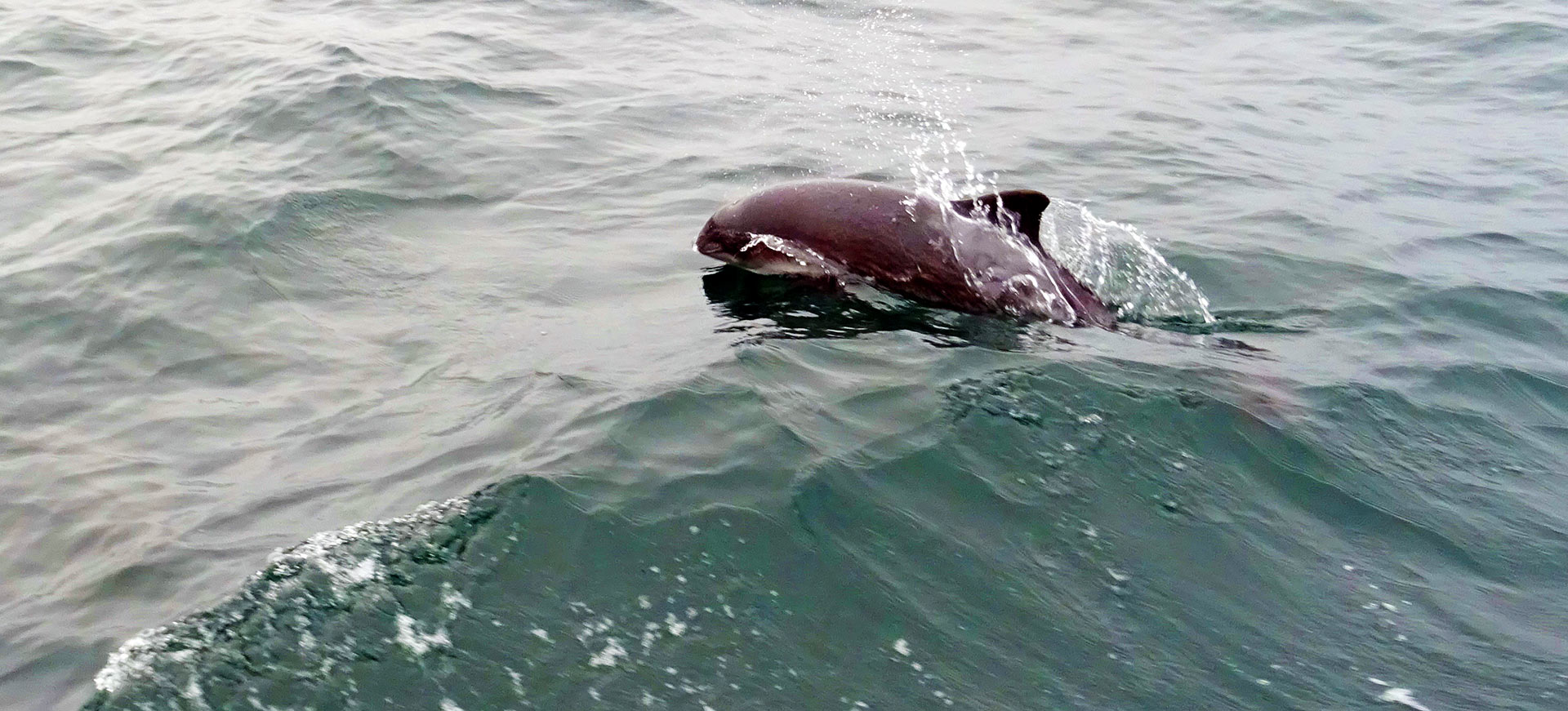
We repaired it that morning. Well, partially at least. As there hasn´t been a connector to the VHF-plug on board we could not make the radio working which I was deeming acceptable. At least we made it too display white, red and green lights in the mast top and that was the most important thing for me. Gedser is a very, very small harbour without any marine service so I pushed Martin to get up very early, get the damn lights running and get out to the sea soon. Which we did. Sailing out of Gedser was a no brainer as wind was still up with some 9 knots TWS. A dolphin greeted us and I took it as a great omen for this second day at sea and was full of hope.
A rather slow start. Once again.
The dolphin wasn´t that sign as we hoped for. The wind eased further more and the boat wasn´t barely making more than 5 knots. Which was still okay for me because our 21 horse power Diesel engine wouldn´t propel us much faster. So, like the first day, we gave in to a rather slow start. Martin was sitting in the Cockpit with his warm clothing on, me too and we asked ourselves where the summer might be and why in the world would we be sailing along in mid-June with 4 layers of warm clothing on our bodies?
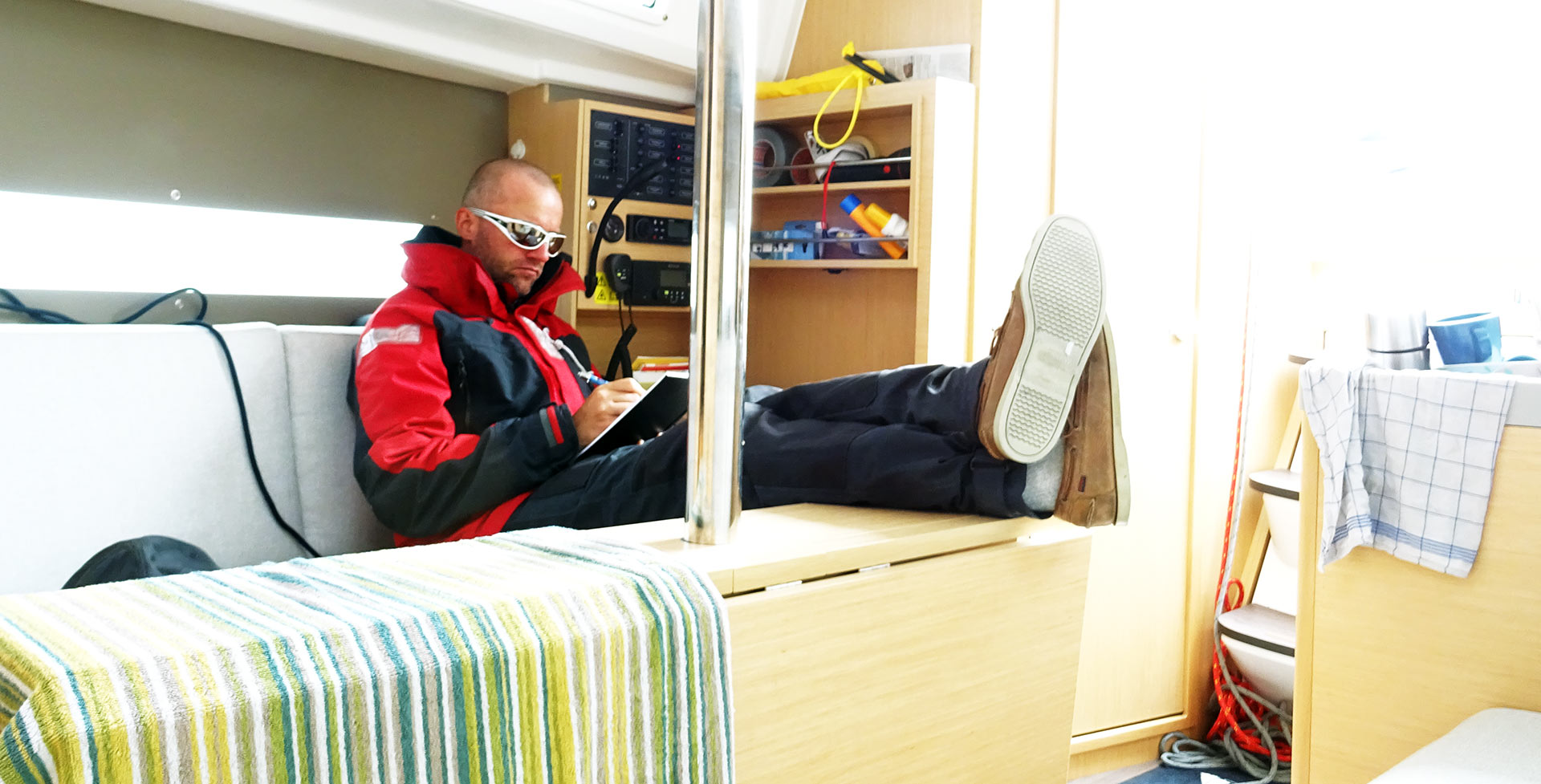
As there wasn´t much to do I retired back down to the chart table to complete the ship´s log, check the engine for coolant and oil and note the current weather and traffic situation. There were three boats sailing out that morning with URSUS: One to our port side was heading clearly north, probably to the Copenhagen area, one was quickly falling behind, a small 28 feet classic GRP boat which was out of sight after 2 hours and one sail dead ahead. This third boat was raising my attention … later.
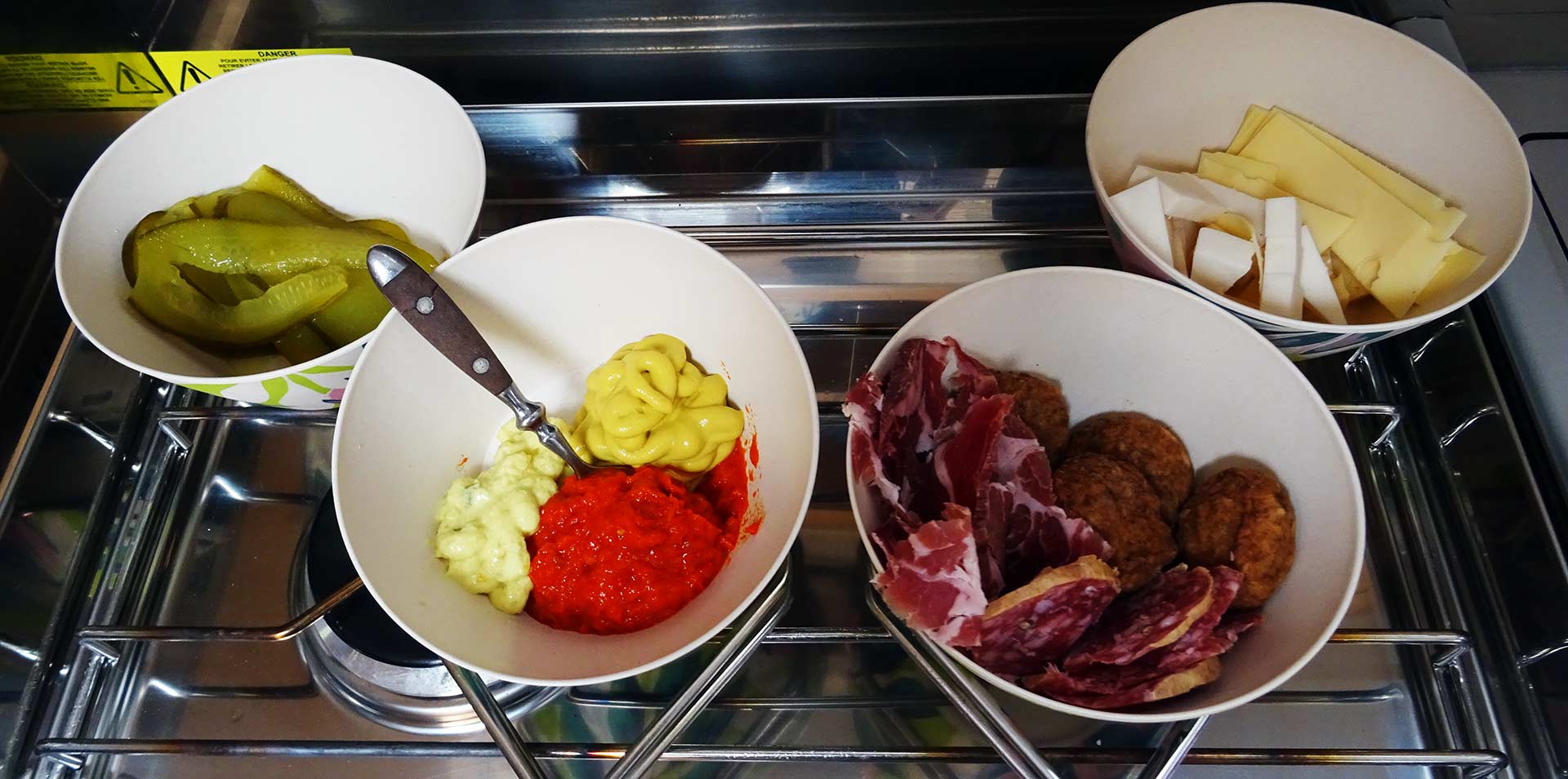
For the time being I reverted to an old recipe to raise morale: Food! As we had just been enjoying a hot coffee that morning for a hasty start our stomachs were aching and a quick look up to the cockpit into Martin´s eyes was telling me that he was craving too. Varying on the good old “German Klappstulle” recipe I prepared some bowls with chopped pickles, fresh veggies, two sorts of cheese, prosciutto crudo and fresh slices of bread. It was a feast!
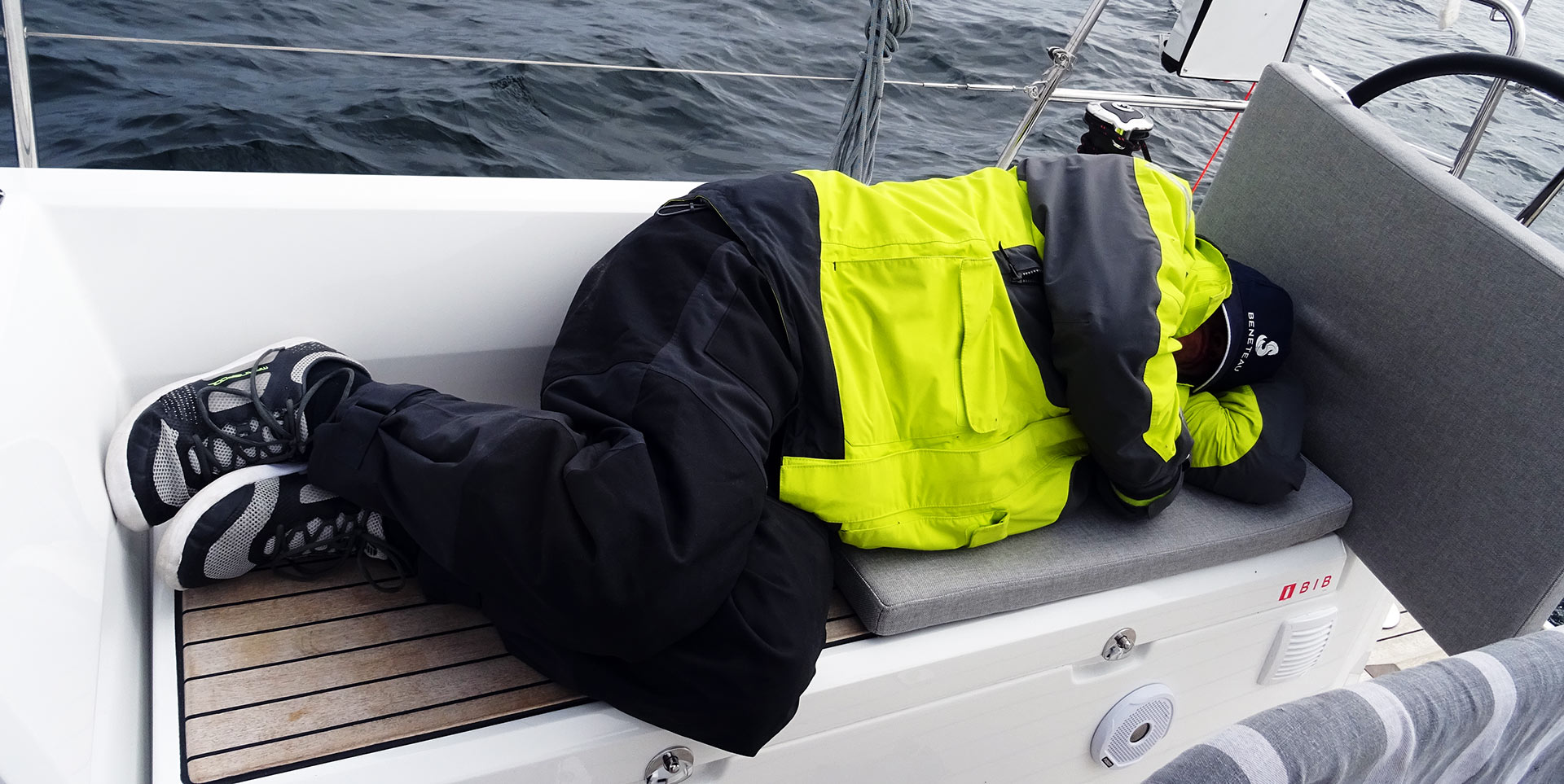
As Martin gave in to another round of sleep – first on the teak bench of the cockpit, later going down to his cabin, I got up my binoculars and began to show some interest in the sails dead ahead: What was it? I couldn´t see all too much as the other boat was too far away, but as the wind started to blow harder – now with 10 to 12 knots TWS – and the boat sprung to life, I – otherwise bored to death – switched to racing mode and proclaimed to myself the aim to catch the other guy. Let´s go!
Racing mode on the Oceanis 30.1!
Oh boy, what a fun this was! Having the remote control of the auto pilot (a small egg-sized thingy on a necklace) ready to hand over manual rudder control at will I first of all got myself cramped behind the windward wheel and began steering by hand. It was such a fun! Because of the fact that I know had an aim and something to accomplish and not just a number on the compass to head the boat to the thrill and joy of racing a boat quickly had me completely.
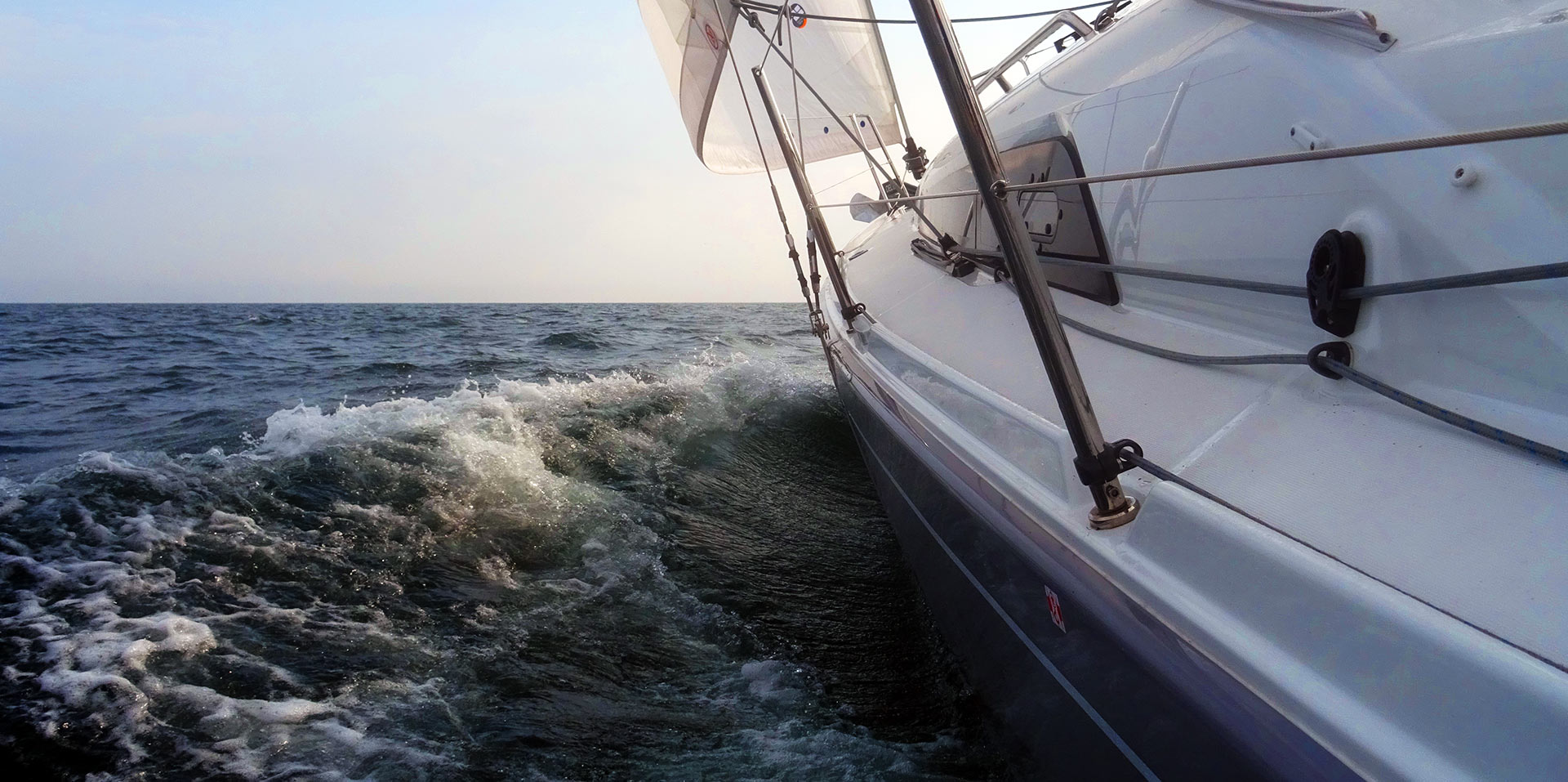
Wind was ever increasing with a higher wave building up by the minute. Now with 13 to 16 knots true wind the boat was overcanvassed but I let her fly anyways. I felt that we were pushing very hard with the Beneteau exceeding 7.1 knots SOG regularly, which was pure joy. 7.1 knots is her theoretical hull speed and seeing this boat going faster upwind was pure bliss! And – see! – I´ve made progess on the other boat as the sails of that ship grew bigger and bigger.
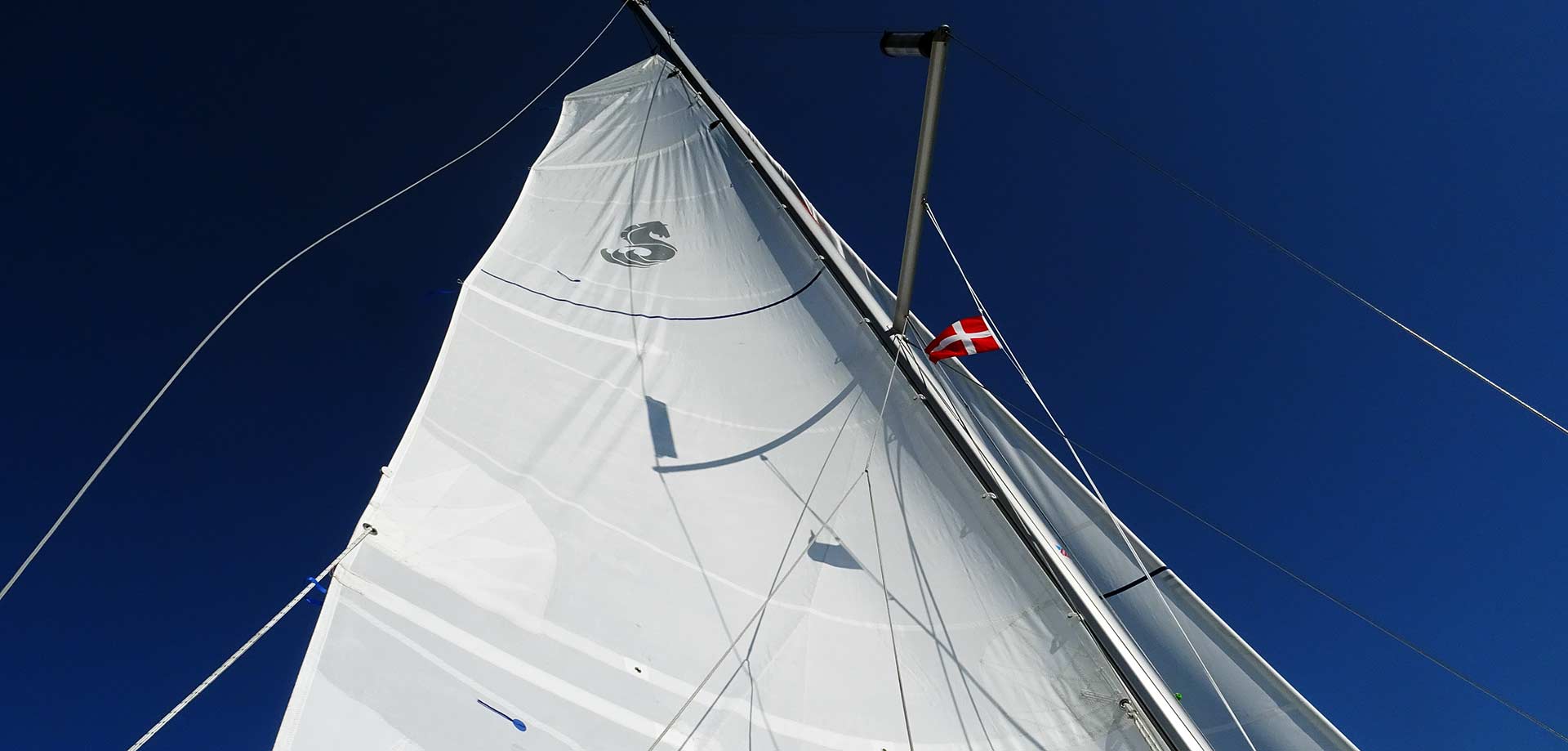
I activated auto pilot with just a push on a button – having this machine switched to “Wind”-steering mode on the chart plotter. That meant that the auto pilot wouldn´t follow a specific heading but have the boat steered according to the wind angle that I put in. Having two hands free now I eased the main sheet and let the main loose completely, took the halyard in one hand and let the main come down with one hand and pulling the line for the first reef with the other. The whole manoeuvre took me less than a minute. Tightening the mainsail again – voila: With wind speeds now at 17 to 20 knots true the first reef in the main was the right decision for sure.
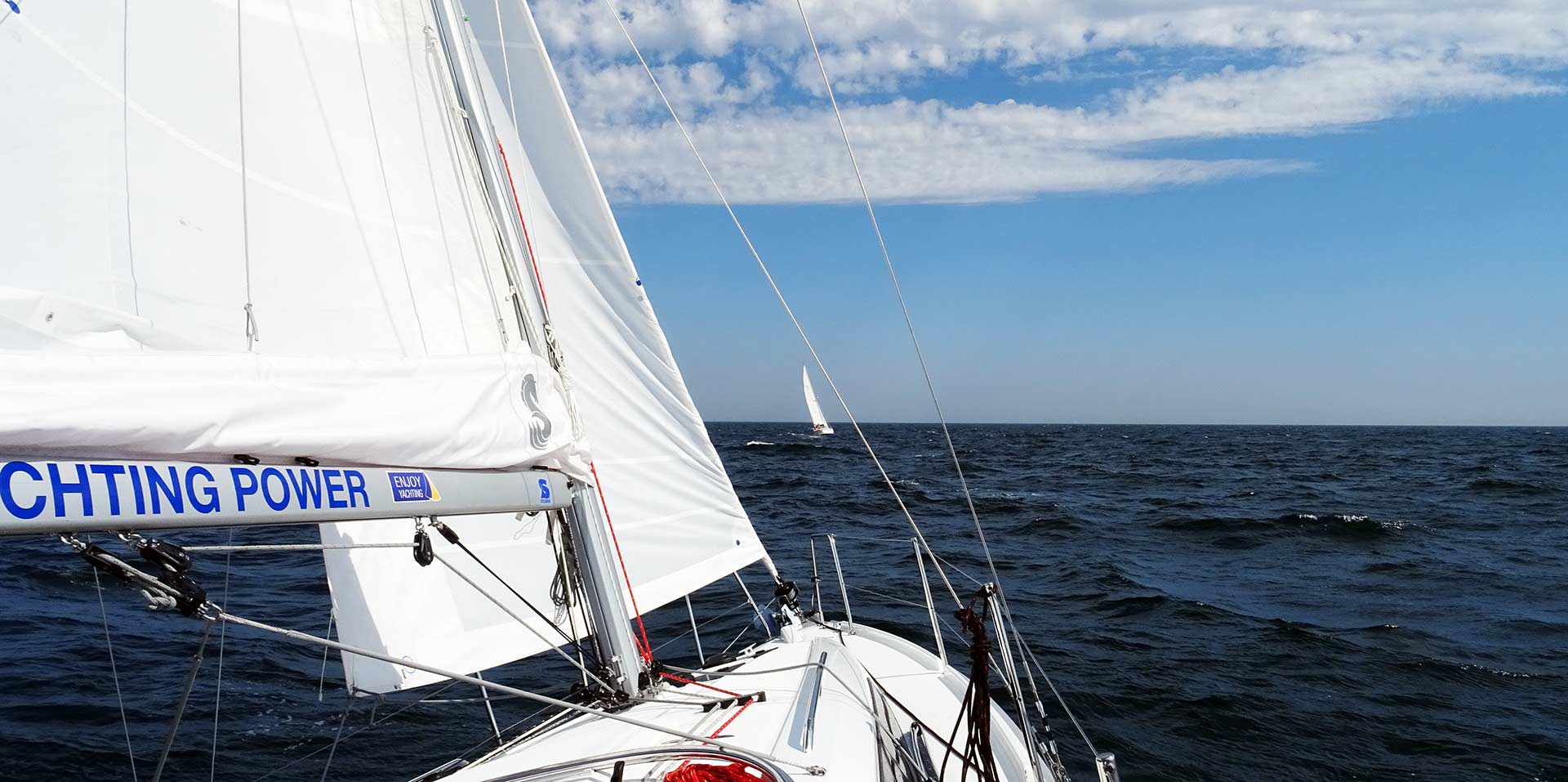
Some twenty minutes later when the wind was again as high up as 22 to 24 knots true I eased the Genoa sheet and pulled in the jib some revolutions. The boat responded at an instance: She wasn´t heeling that much anymore, I felt less pressure on the rudder and … we haven´t lost a single knot! The Oceanis 30.1 kept on flying and I cheered in pure joy: The other boat was now well in sight, make it 10 boat lengths and I clearly had made to catch her!
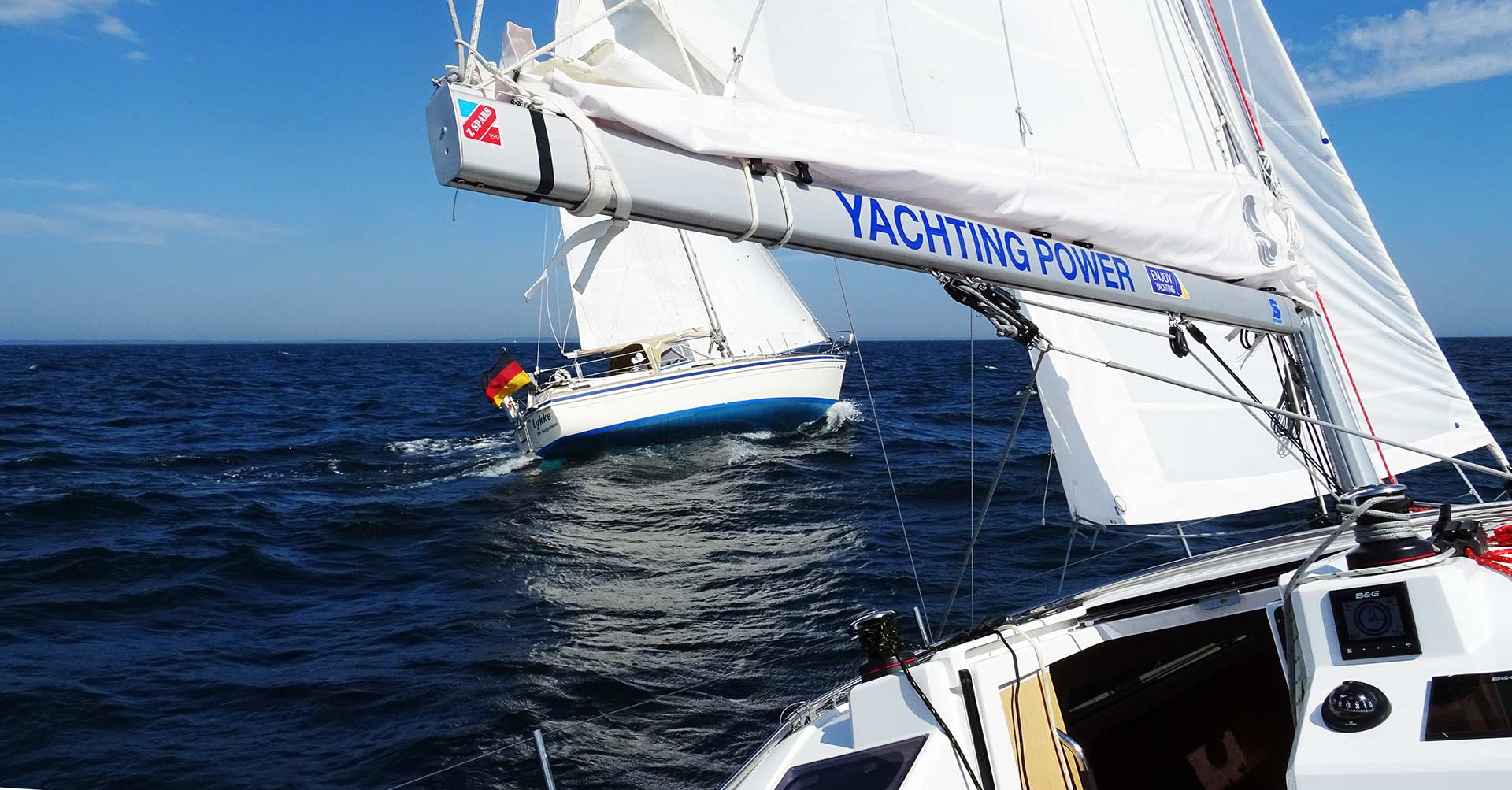
Martin woke up in the course of the hustle my reefing action created and stuck out his sleepy head through the entryway: “You need help, Skipper?”, he yelled against the roaring winds. I smiled, shook my head confidently and pointed my nose to the bow: “All is fine!”, I screamed: “Look there!” When he understood he smiled as well and became suddenly infected with racing fever just as I was. We came closer by the minute now and although the other boat was high up on the wind I was able to squeeze out one or two degrees more than him. Luffing, bearing away a bit gaining speed, reducing distance and luffing again. We could see the other boat rocking heavily in the waves – I wondered what a gracious sight our own boat must have been.
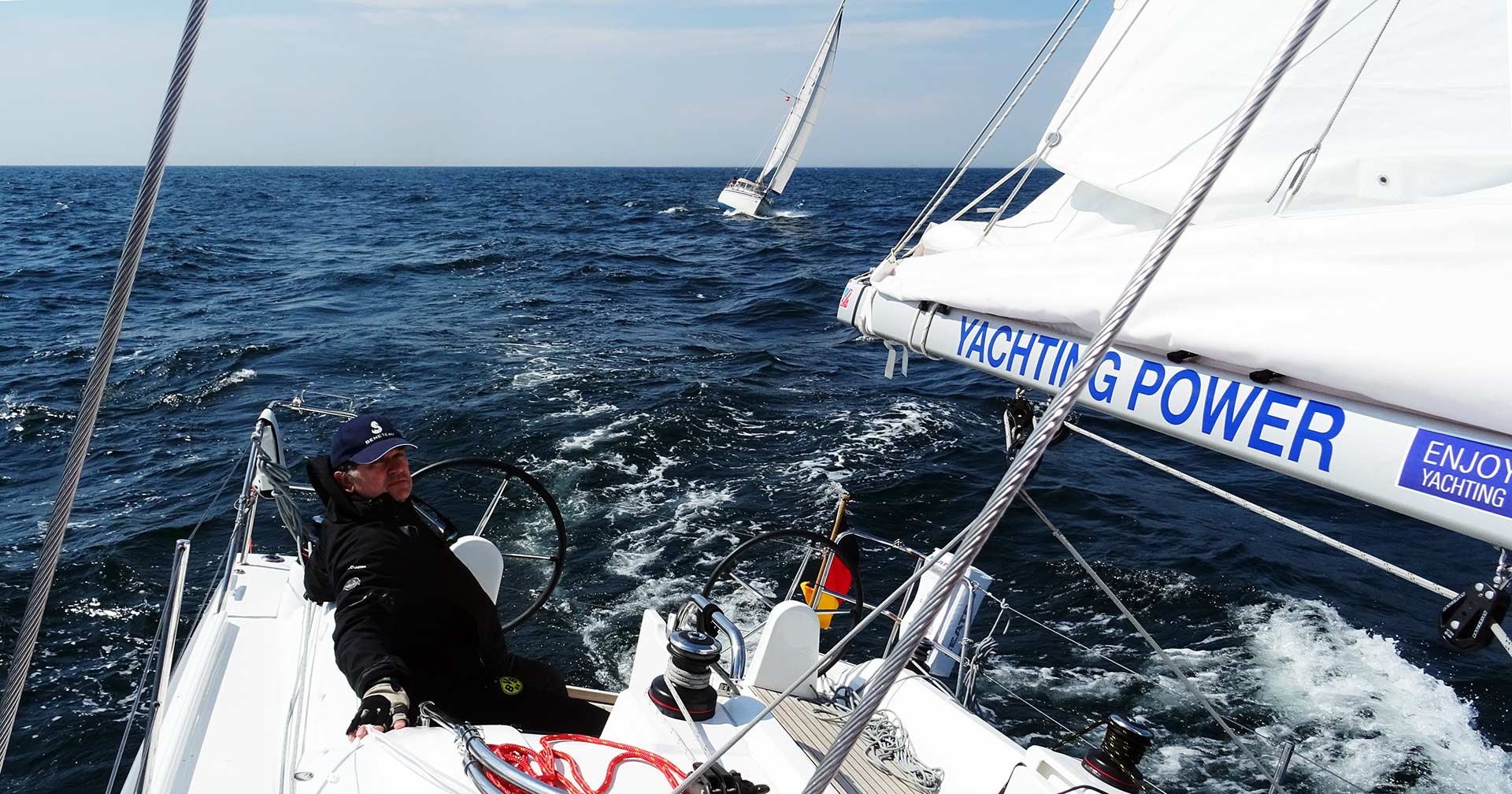
Then the moment came when we had him! Another finaly luffing and URSUS catched up. We overtook him. The other guy – German flag – was waving and greeting, we were too. The fight was over and I handed over the rudder controls to the auto pilot again. I had personally steered the boat by hand during this final hour of our little “Baltic Race” and it was pure joy. The other boat was a Malö 31. A heavy displacement classic GRP boat with a long keel and a deep V-hull. She was riding the waves graceful as a ship can master the Oceans. But she was slower. Half a knot, I would say. “That´s the difference between old and modern yacht design”, I said to Martin and wondered.
Reeled by reality
Martin was awake and full of enthusiasm: “Hand me the helm”, he asked and suggested that I should also take a nap down below. I agreed and just when I was about to hand over the ship to him I noticed something strange in our stern wave. A closer look confirmed that something got caught in our starboard side rudder blade which we dragged behind the boat. I went down to my knees to try to reach it – hoping that we wouldn´t have to stop the boat dead in the water to ease the power of the water flowing around the rudder. Lucky me, the Oceannis 30.1 is so small that you actually can reach for the lower end of the transom and I could pull the stuff aboard.
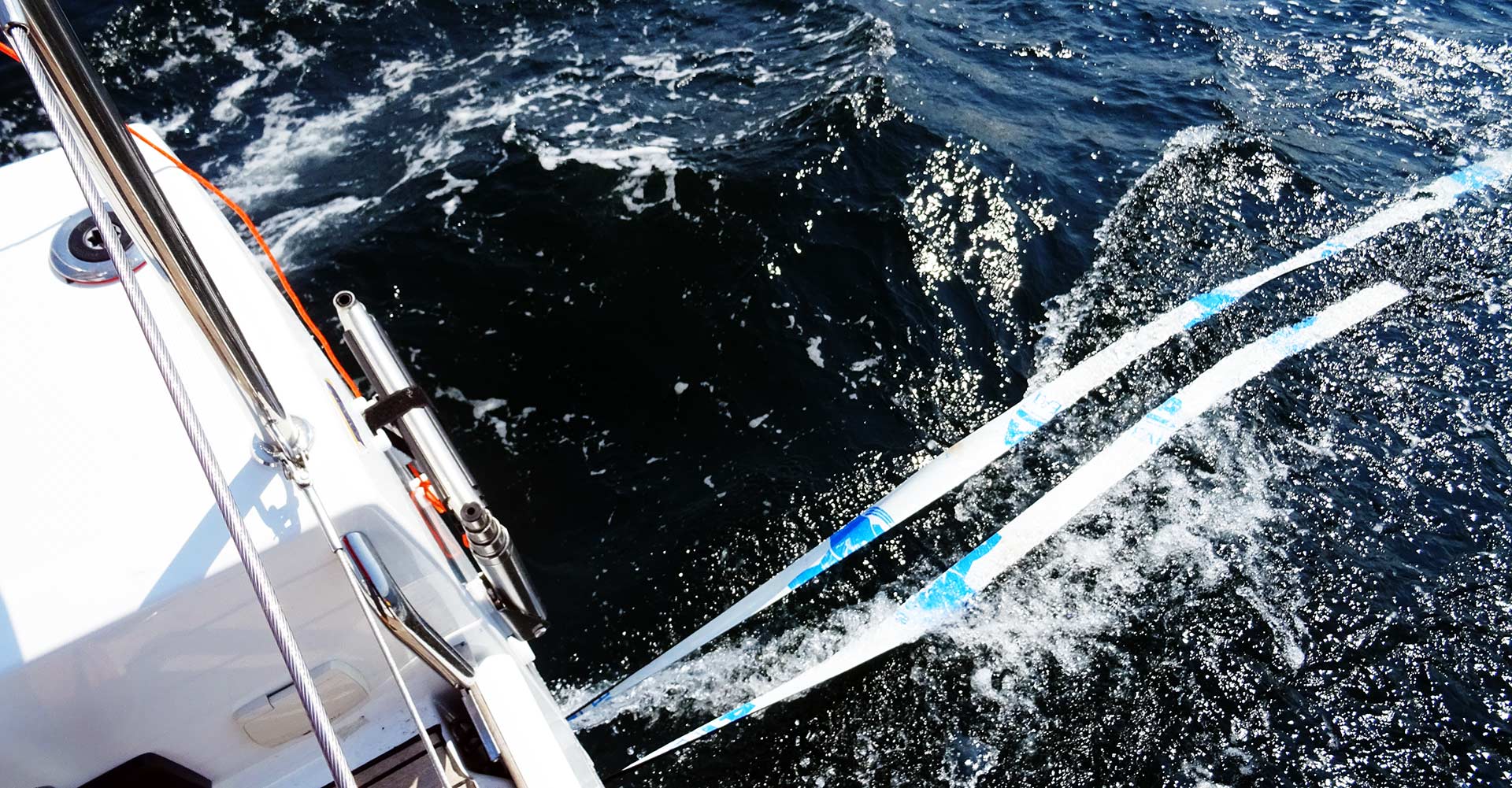
It was a more than 10 metres long thick rubber band. We had been lucky that the garbage wasn´t entangled too much with the rudder shaft and I could remove it without problems. The rubber seemed to be in the water for not so long as there was just a small slimy layer of algae. It got probably lost to the sea a few days ago. I smiled: “That´s also modern yacht design: Double rudders …” We put the garbage aside and I went down to catch some rest for an hour or a half.
Decisions
I got up rather earlier than later. The boat was rocking so hard that I couldn´t get myself to fall asleep nor to find some rest. I went back to the cockpit and Martin was still steering by hand. He had fun in doing so. “Where is the other boat?”, I asked and searched the horizon. Martin pointed to a bearing much more to windward than I had expected. So he was bearing off from our upwind course for 10 degrees to get off some of the stress generated by the ever increasing winds. And he wasn´t steering by hand all that time, apparently, as he activated auto steering and showed me his smartphone: “There is network coverage out here!”, he triumphed and opened a weather forecast for this area. Not so nice! The forecast expected a thunderstorm coming in from the South with wind speeds exceeding 30 knots and afterwards during the night wind speeds of more than 25 knots. “Too much?”, he asked. I just nodded. Too much indeed.
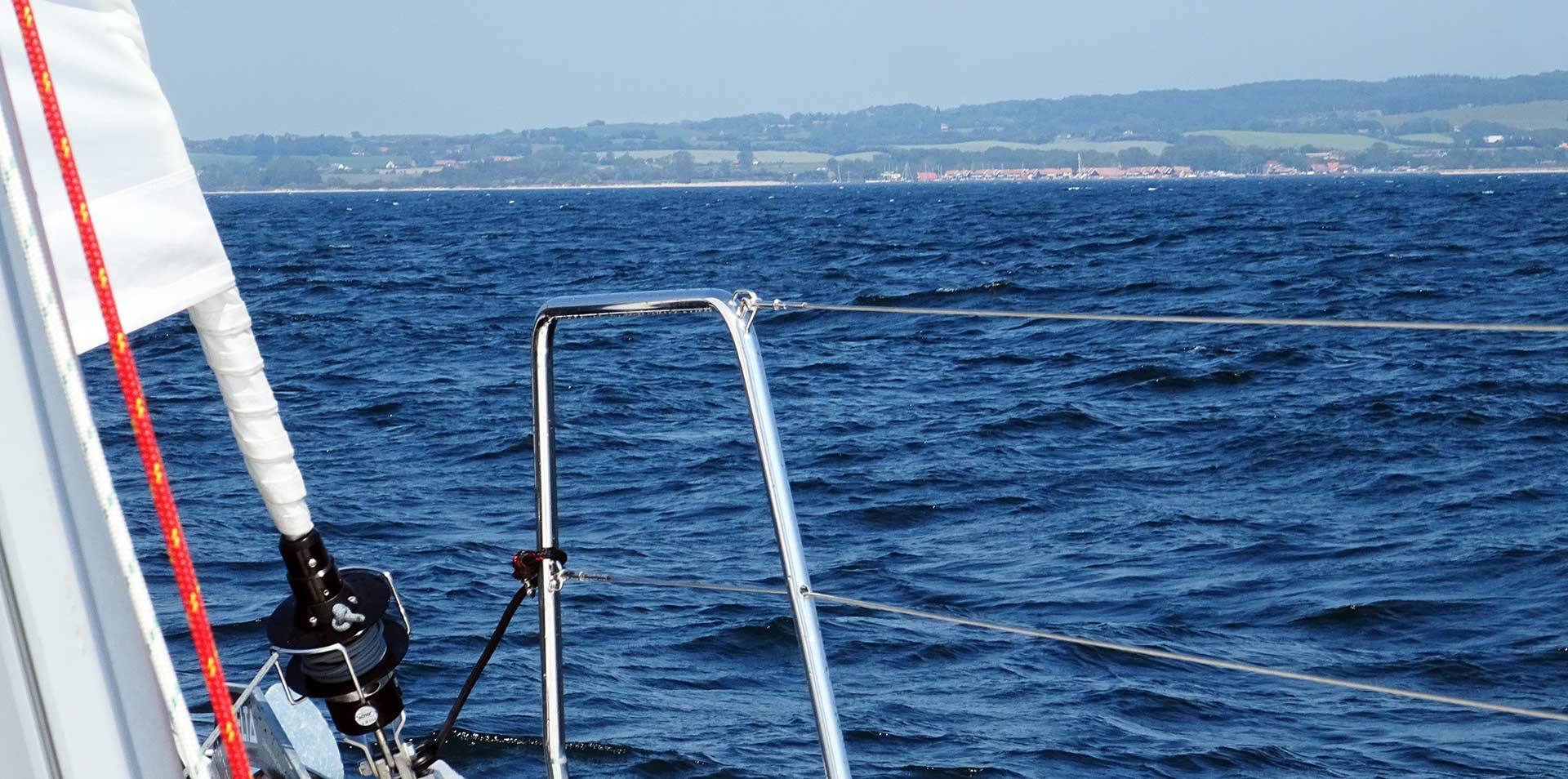
As much as I had loved to sail on through the night to have reached the island of Bornholm the next day it just wasn´t safe. The Oceanis 30.1 is a fast, tough and very seakind boat as far as I could say after two days of sailing her but I found it rather risky to head out to the darkness and right into a heavy thunderstorm front knowing that winds would be resume to be blowing much harder than 25 knots for hours. Martin had never sailed through the night and although we got our nav lights working we still missed AIS. And there was a major TSS upcoming between our current location and Bornholm. A knew from my past trips to Bornholm that this was a big point of intersecting traffic. I didn´t wanted to be sailing around in a sub-10-metre boat in tough conditions without AIS. I decided to have the boat landed that night too.
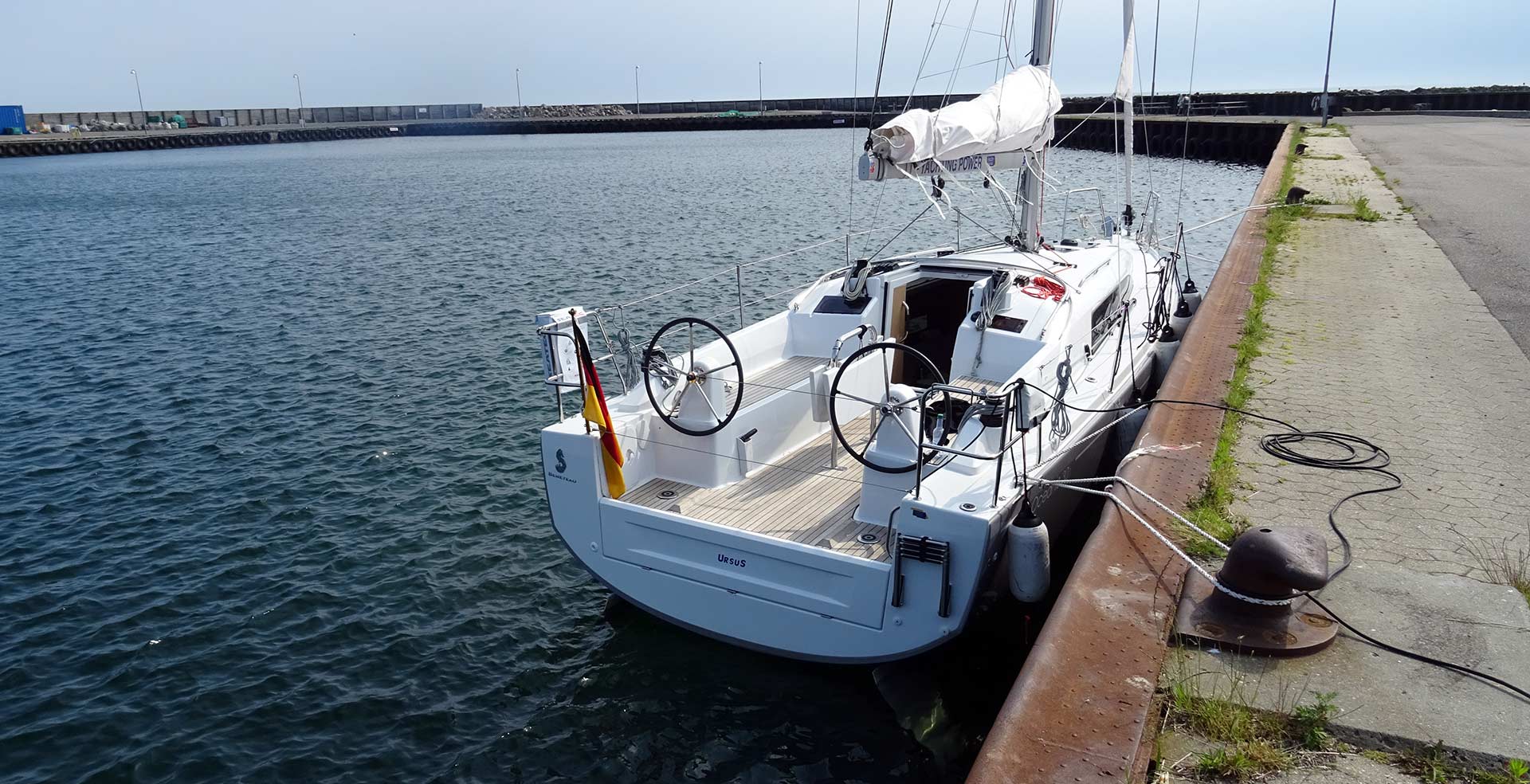
So for another time we luffed a bit further and had our course set to nearby marina of Klintholm which I had visited some time before. I pretty much liked this harbour – in fact, Klintholm is an absolute classic for all summertime Baltic sailors coming from the West heading to Bornholm and Sweden or Poland. Gedser, then Klintholm is a classy chain of landfalls and we now joined this procession of yachts. Other than yesterday when I was a bit down having to make landfall in Gedser, this time I was happy. I really looked forward to seeing this cosy, tidy, little lovable marina again.
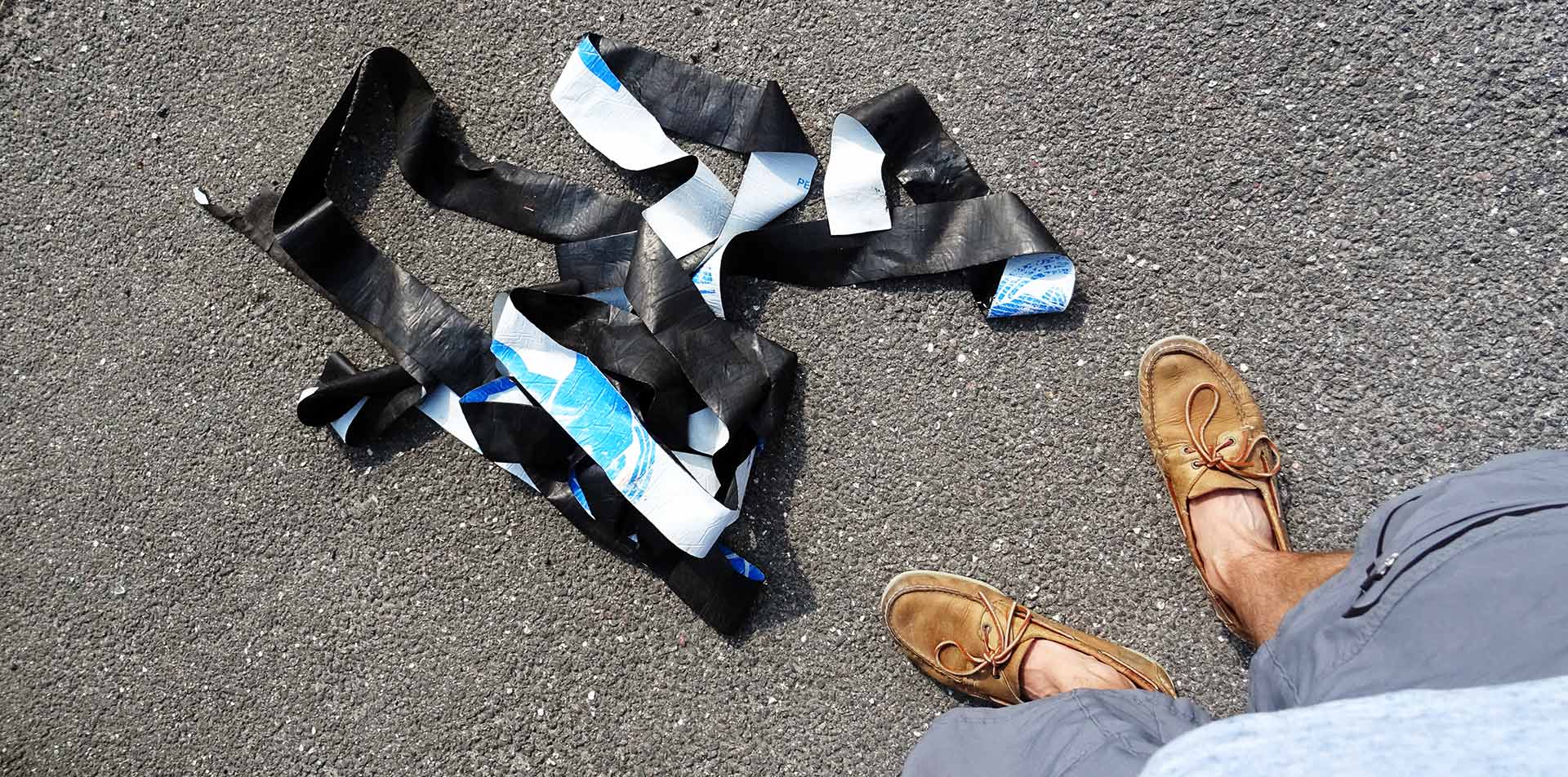
Finding a berth was a no-brainer. Upon entering the breakwater one can choose between the yacht-marina to left hand side or the fishermen´s harbour to the right. I could judge by counting the masts through my binoculars that the harbour was quite filled and when three other boats made it into the harbour just minutes before us still circling around in the small basin in search for a berth I didn´t even try to moor in the yacht´s harbour and landed the boat in the big fisherman-basin which at this point was absolutely empty. Nice. After having the boat tied up safely, packing of the main and having it rigged for the upcoming thunderstorm I got rid of the rubber garbage band.
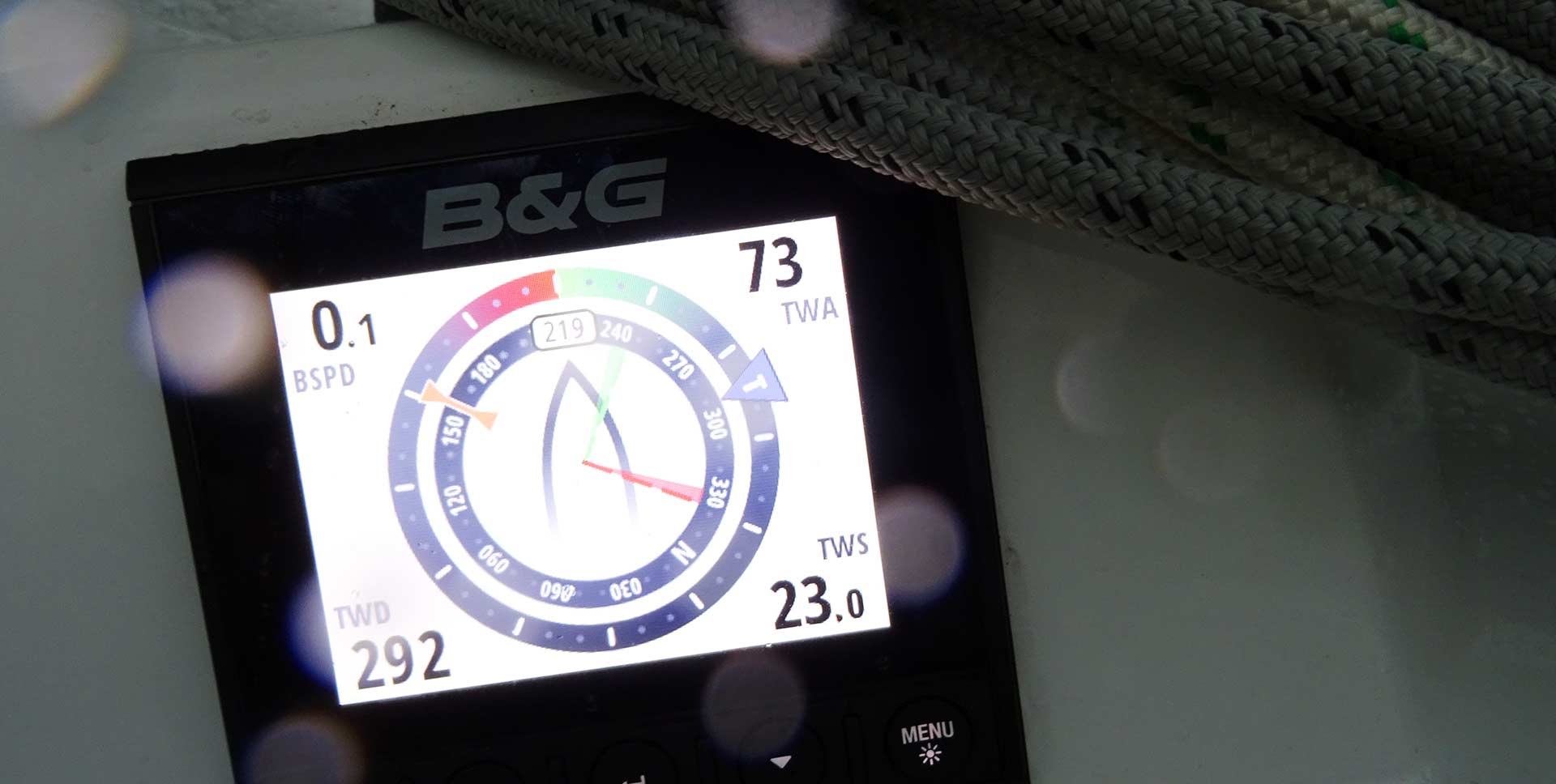
We took off our sailing clothing and sat down in the cockpit, surprisingly enough the sun came out and we opened the traditional “landing beer”, cheering our great “racing boat” and to Rasmus, the God of the Winds. I couldn´t finish the beer as fast as the thunderstorm arrived. Thick clouds suddenly came flying over the land, darkening the scenery. We fleed down below just right on time: The downpour was hefty! After the biggest thunder went by, I was able to stick my head out into the rain and have the anemometer pictured: Winds had been steadily blowing at 23 to 26 knots – in the marina! – and in gusts the boat was heavily rocking at her lines banging into the pier (rubber coated) side. I looked to Martin: “This would have kicked our asses that much. Our decision was absolutely right, man!” I found hardly any sleep that night, the wind kept on rocking the boat.
Sweden-Ho!
It was early. Very early. Again. Yesterday before we went to bed I checked my three weather forecasting platforms, taking notes of when which wind from which direction and in which strength was to be expected. The three websites nearly predicted the same. And he consensus was that wind was to be easing gradually through the night and during the morning hours just to come to a complete halt around 11 to noon the following day. So the motto given out was “up and out as early as possible!”, which we did. Lines were taken in at 5.00 a.m. that morning.
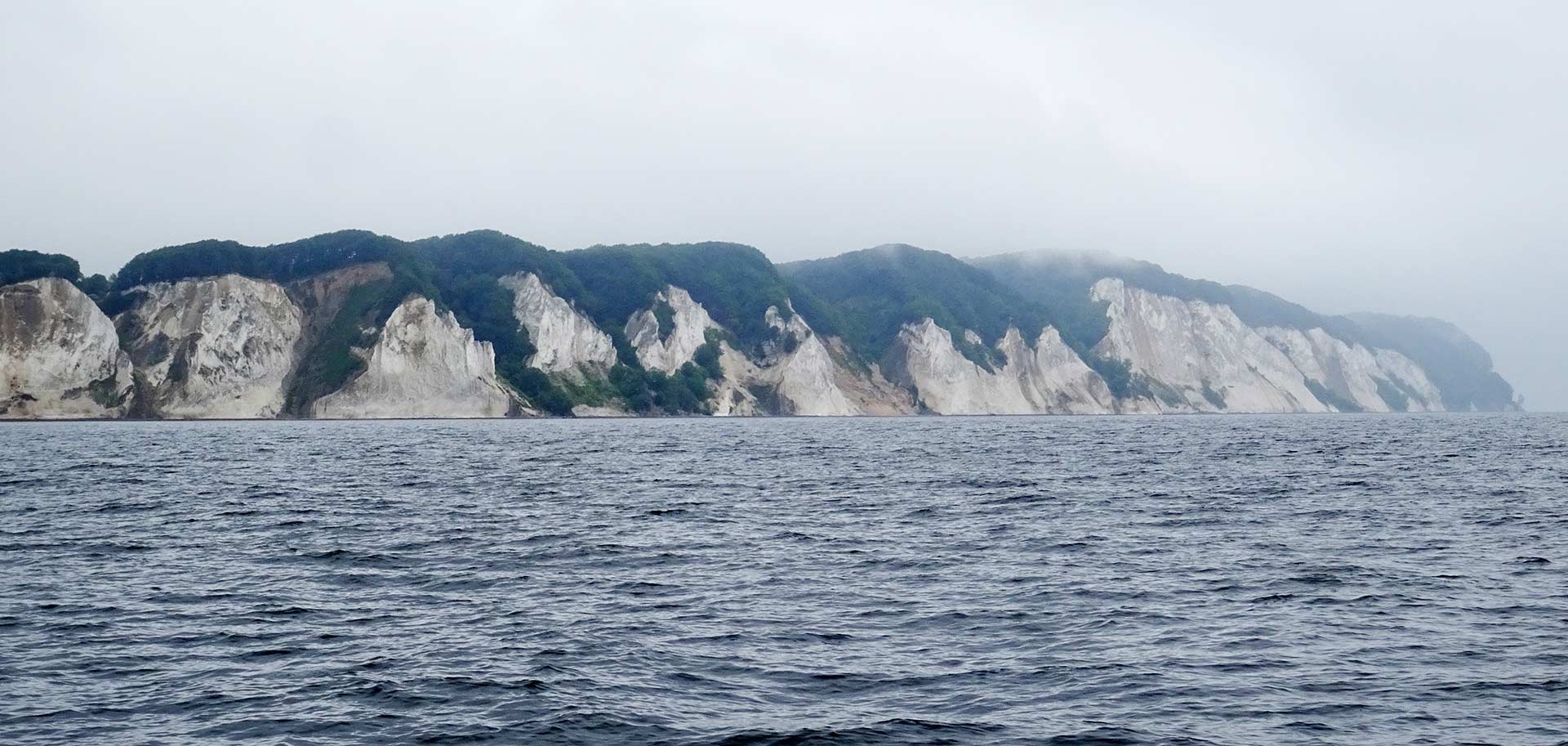
There was still some fog outside of Klintholm and two other boats did as we did. I had all canvas up and set when we came out of the harbour and had to steer due South. Wind was blowing at 9 knots true and we barely made 5 knots. “Let´s wait until we have rounded Möns Klint”, I said to Martin who was half asleep when all sails had been set and the auto pilot took over. I watched one of the boats in our stern waters preparing their Spinnaker to be set. I had an idea.

After rounding the Cape I hauled the large sail from the locker and brought it to the bow, connected the sheets and the halyard and within 5 minutes we had the Gennaker up. Rolling in the Genoa the puffs filled the light garment and I could feel the boat being pulled by the large sail. The fun lasted less than 10 minutes, it was over that fast that I could not even take one single picture. Again. I started the engine. The calm had us earlier than expected. I saw the other boats taking down their sails too. “Prepare for boredom!”, I announced. It wasn´t really funny. After three hours the spook was over and wind returned. And how it returned! Other than forecasted, we got a load full of blows to an extend that I again had to put reefs into main and Genoa.
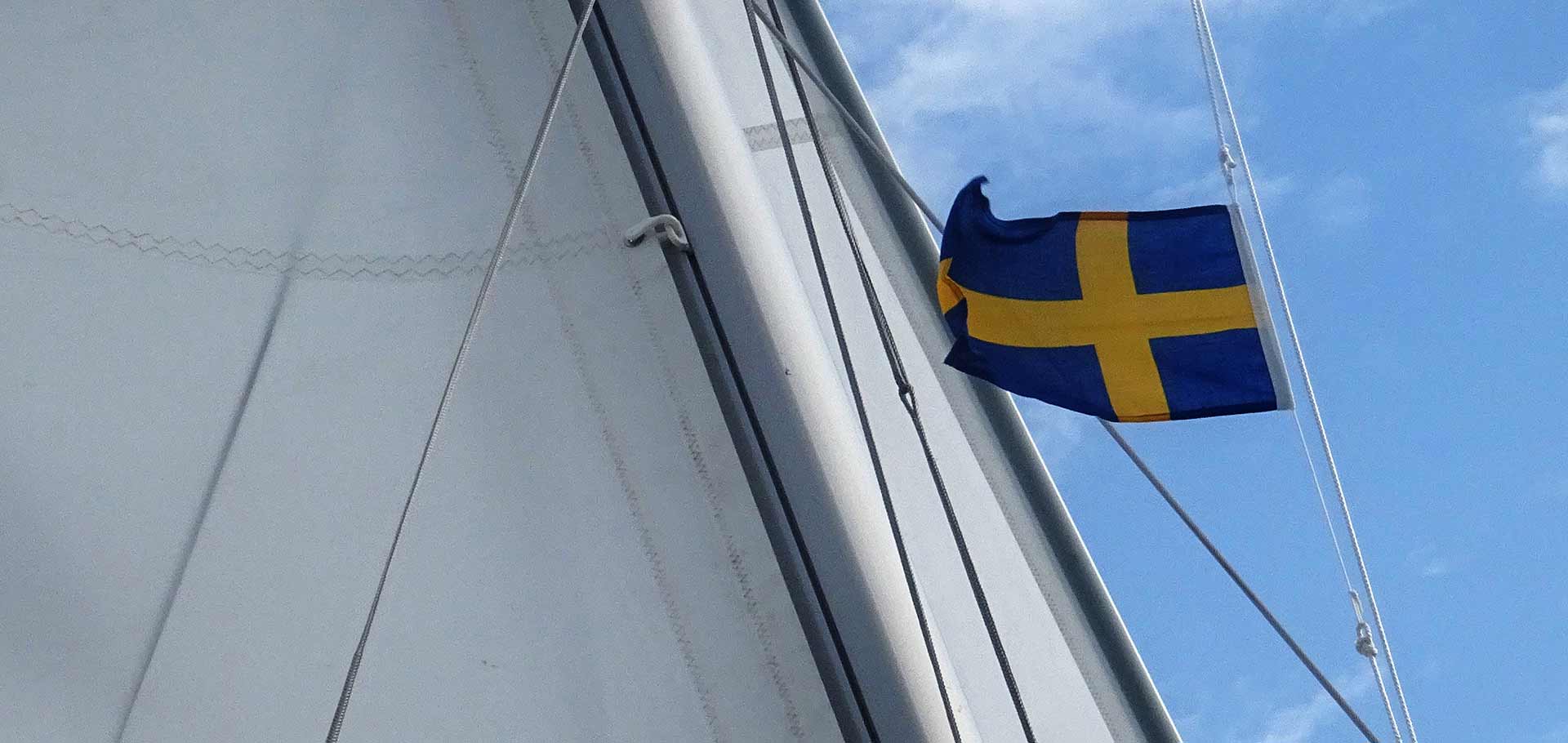
Mood was high up again and as the boat was steadily sailing I went to the flag halyard and took down the Danish curtesy flag to have the Swedish hoisted. Martin came up and was bewildered: Hadn´t we planned to go to Bornholm today? “Yes, we had, but see: From here it´s a 25 mile detour down South to reach the harbour of Hasle on the Western shore of Bornholm, 15 miles more to round the North Cape and go for Gudhjem. As much as I´d love to see that lovely island again, we have to shove off some miles from our trip in order to reach Stockholm! Had we sailed through we would have git the time, now, with 2 full nights of sailing lost, we had to make up for it.” Martin perfectly understood and agreed. The boat made a steady progress as I had her steering towards the Southern tip of continental Sweden, Sandhammaren. Two freighters exiting Bornholm TSS came near and although I as a sailing vessel had the right of way I changed course in advance to prevent them from having to. One Captain was even waving at me, I greeted back.
Into the thickest of fogs
Hours later, 20 miles still to go, I noticed another weather phenomenon. There was a thick cloud building up to starboard side of the bow over the horizon. At first it was clearly white, then it became grey which added a dangerous aspect to the scenery. We were sailing fast, 6.5 to 7 knots but it seemed that this cloud – or was it a roll cloud or something? – was building up very fast indeed. Was this another thunderstorm? But where was the super cell? The cumulonimbus? I steered at the thing coming up and not really knowing what was going on I ordered the sails to be taken down and the engine started. It wasn´t my boat and it was a brand new one – the prototype – and I did not want to risk anything that could bother with both ship´s and crew´s safety.
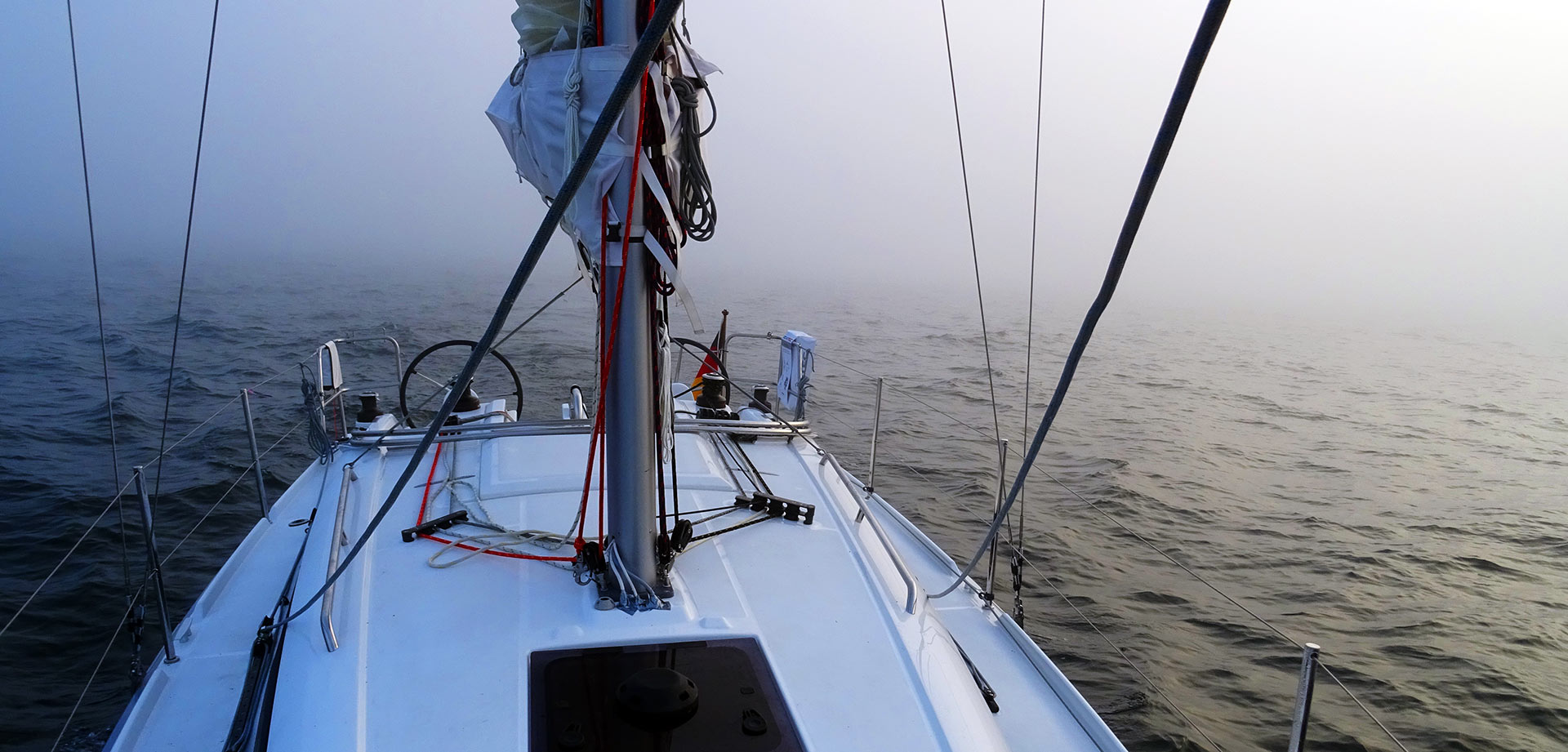
Well, it wasn´t a thunderstorm. It was the opposite: A dead fog. The thick white cloud encapsulated the boat as fast as it was approaching us. I´ve never seen anything like this. I had the navigation lights switched on – it was 8 p.m. and the sun was apparently low, yet it was full daylight. I was hoping that this was just a fog bank or a “drifting” cloiud or something and that it would pass by as fast as it had approached us. But it wasn´t. Wind fell to practically zero within minutes. Waves disappeared, water became lead.
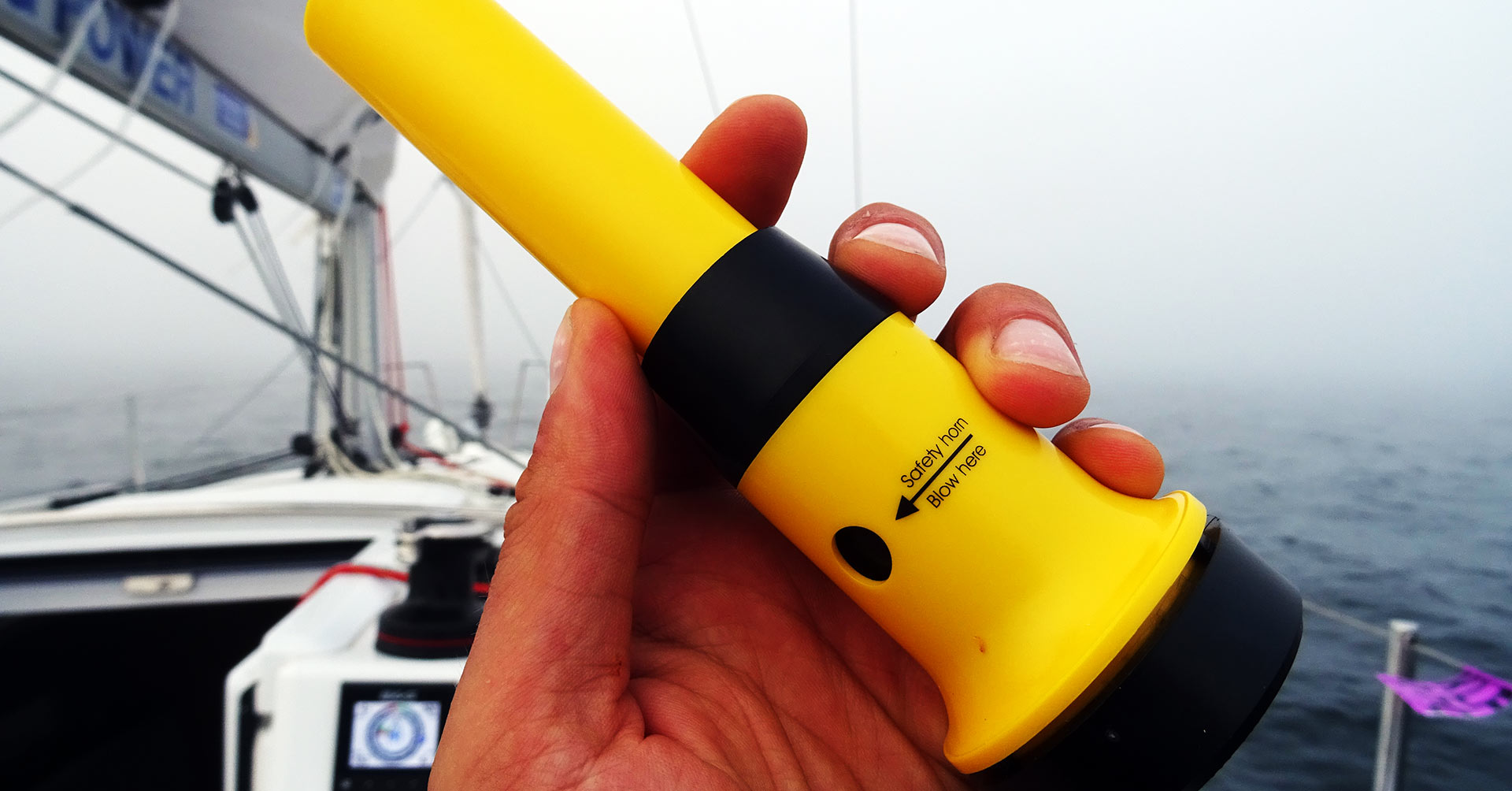
Temperatures dropped 8 or 10 degrees the least and we had to take on our oilskin clothing again. I thanked my boss who insisted to have the boat equipped with all the safety stuff and so our “Mini-Trump”, which was a source of constant political jokes – finally made it out of the box and into the cockpit. As the visibility was down to under two boat lengths and we were approaching coastal waters, I began to blow the fog horn. One long tone followed by a short one. Which of course was utterly wrong (my sailing teachers may forgive me!). Martin quickly jumped to the rescue and searched the internet for the proper signal: 3 long blows, of course, every two minutes. This we did – for the coming 4 hours!
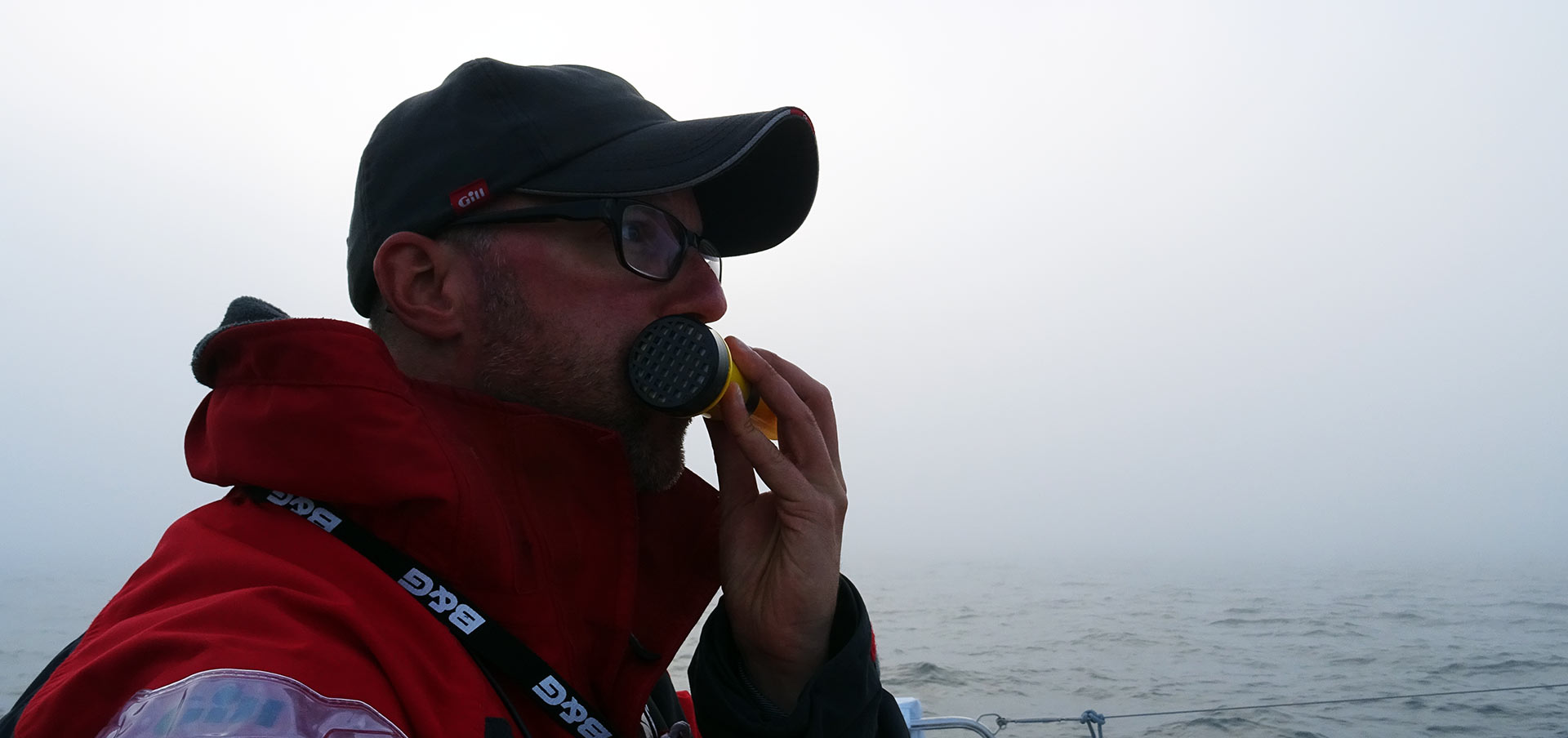
The fog horn is a hell of a horn indeed! It is so loud that when having blown it I was virtually deafened for quite some time. Just when the tinnitus ringing in my ears had eased, another two minutes had passed and I had to blow it again. I cursed the sloppiness of the rigging crew and my own failing as skipper in checking all equipment once again as I had to admit that without AIS we were totally blind. It wasn´t a particularly comfortable situation. The tension in me was rising accordingly to the sinking of the sun.
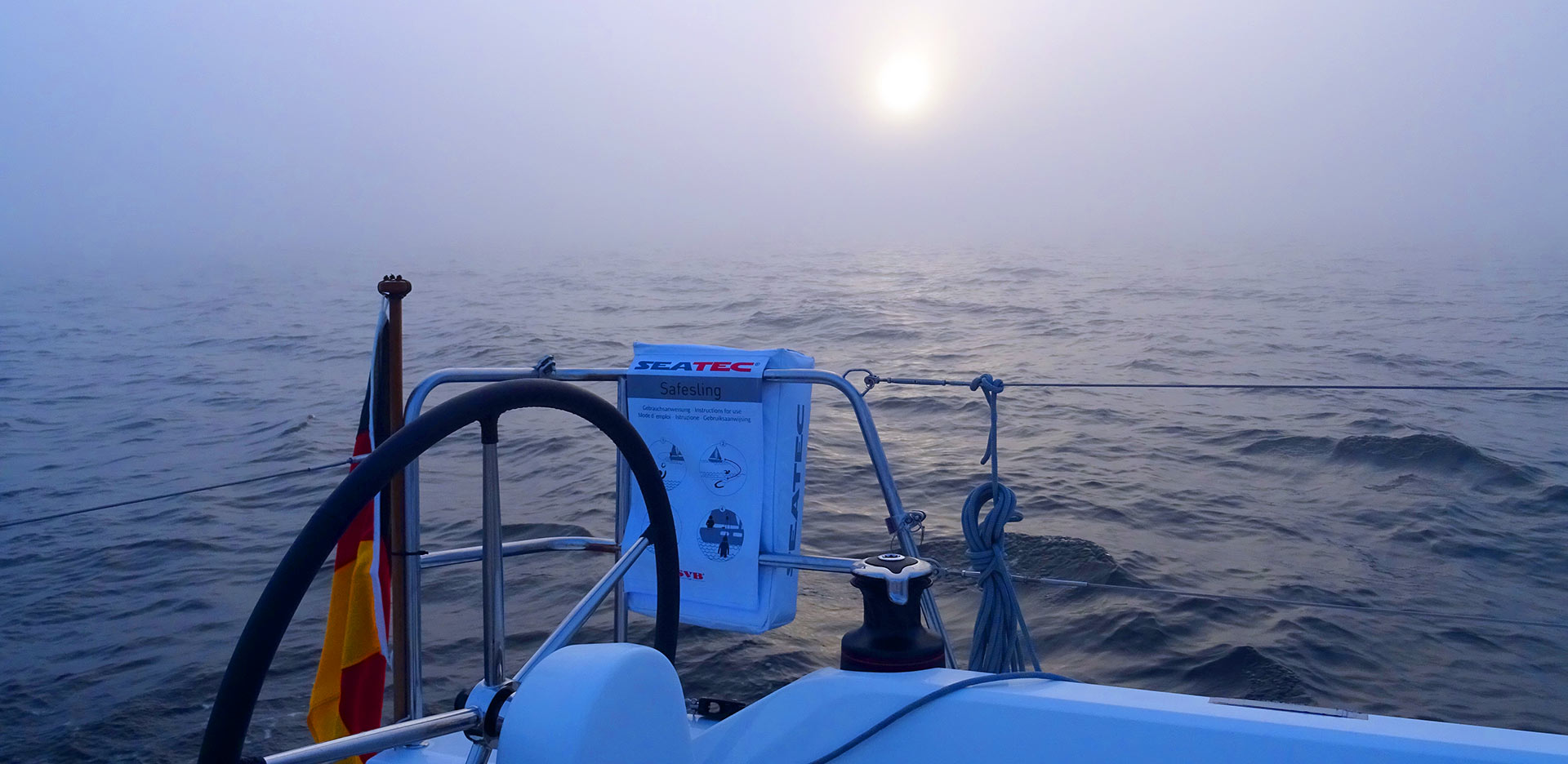
We were heading for our first Swedish harbour, an old friend of mine: Simrishamn. I decided to go here because I could very well remember the given structure of the harbour from my past visit and that was a measure of safety. Anticipating a landing operation under these very, very low visibility conditions I´d rather go for a know harbour. But still 8 or so miles to go. We passed two cardinal buoys marking shallows which I used to determine the accuracy of our digital naval charts. The buoys came into sight with 80 to 100 metres difference than on the plotter. Then the sun went suddenly down and we were in complete darkness. I could see the mast top illuminate a large portion of the fog. Preparing fenders and lines at all sides of the whilst we were still long before landing was a measure to have the boat ready when landfall would occur. Then the coast line came into sight – the fog was still very thick. Was that a breakwater? Where is the green and red marking of the entrance? I was very focused, heart rate easily exceeding 200. “Send a prayer that it will turn out just fine …”, I joked to mask my nervousness. And then … a wonder happened! Just 80 metres before the entrance to the harbour we … dashed out of the fog! There was a clear black sky, a near-full moon and a fully lit harbour! I screamed in excitement and we landed the boat at half past 1 a.m. as easy as ABC, had a quick cold beer and fell asleep. Happy sailors we were, indeed!
Now, a real Thunderstorm for Breakfast
Like a curse, as Martin said, that may be spelled upon us: “It´s my vacation and I simply can never sleep enough!” We get up at 8 a.m. which from my point of view was a courtesy to our late/early arrival after the adventure in the fog just hours ago. I had the boat landed at exactly the same spot where I was one year before with the aluminium built one-off AMAROK and thus we didn´t had any shore power to recharge the batteries. They were down and that could mean soon to have no auto pilot. A fast coffee, then we casted off.
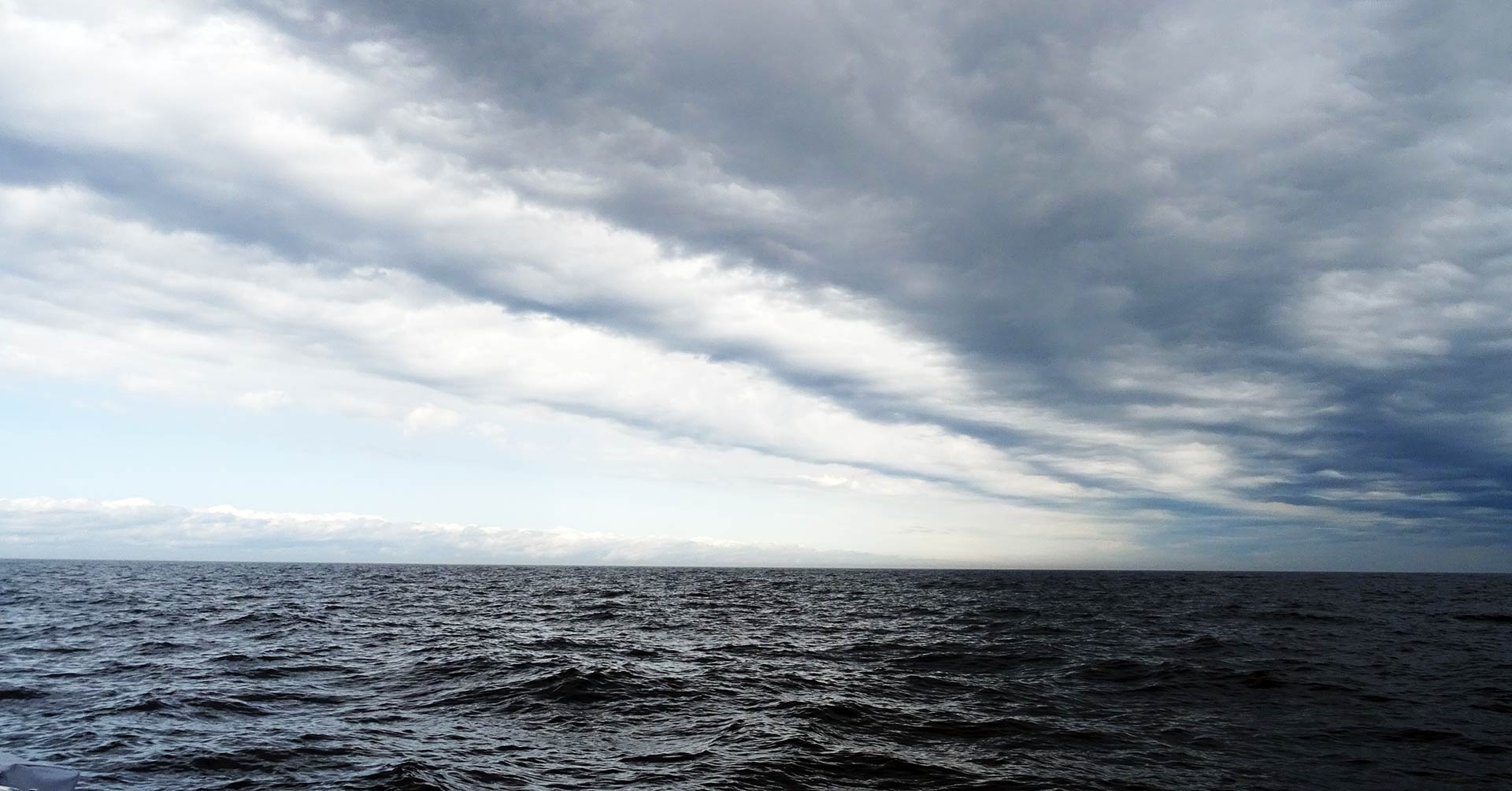
Leaving Simrishamn after just barely 7 hours here was a pity because the town was lovely and surely a nice sight to stroll around, enjoy ice cream and a proper steak. But we had to make some miles, as I announced the day before, and looking at the charts I came up with another change in plan: Instead of heading directly for the Island of Gotland which was a 185 miles trip if sailed directly without tacking, meaning at least 37 hours of sailing, I decided we´d go for the Island of Öland. “What is there?”, Martin asked. But before I could answer a change of weather made us reacting quickly: “Wait! Start the engine, let´s take down all sails!”, I demanded and right so it was!
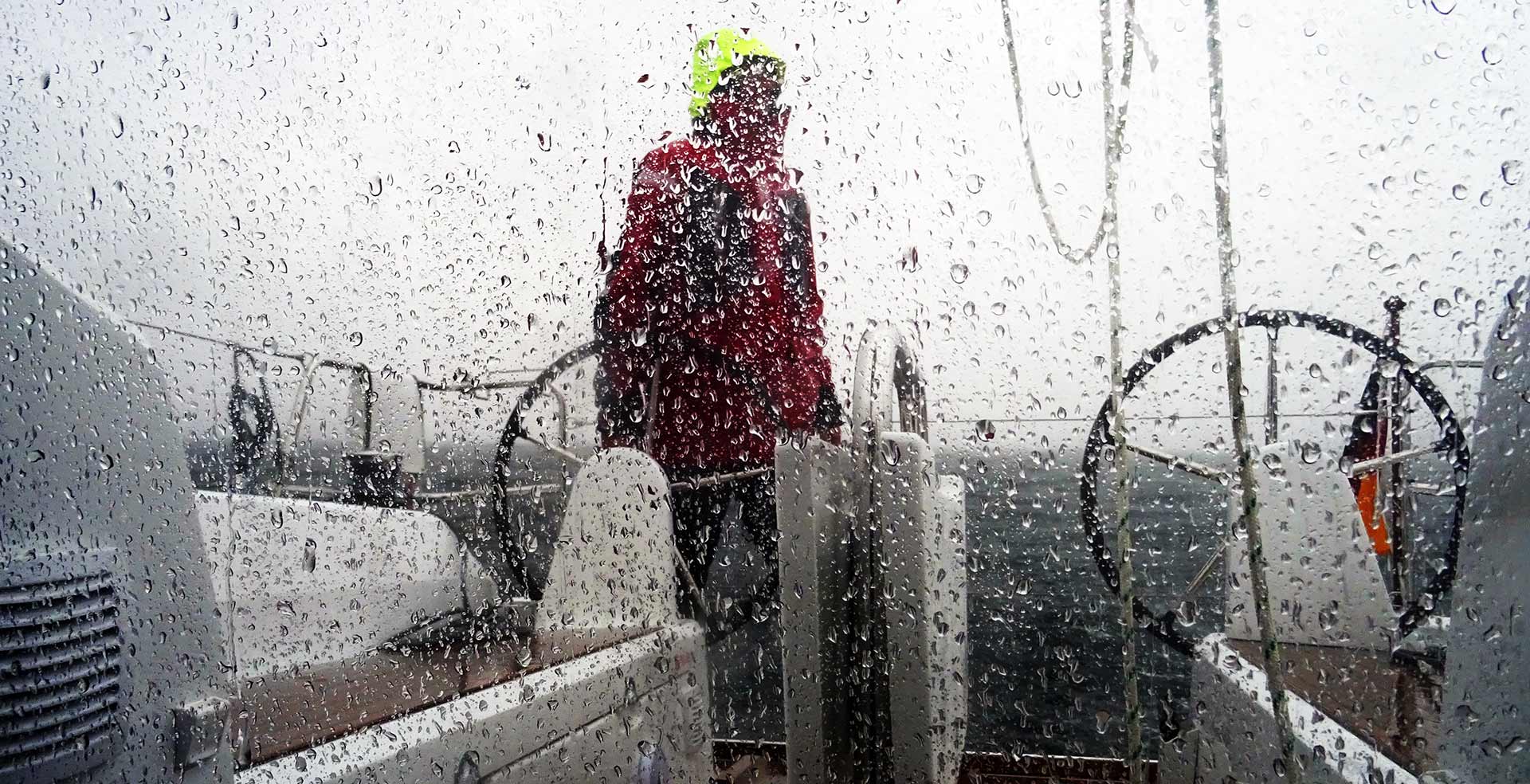
Thick, low clouds approached fast from behind, followed by sudden abrupt changes of wind direction. The force of the wind grew stronger from 17 knots to steadily over 22. One minute upwind, the other a reaching. And then it went dark. I quickly threw over my oilskin and had Martin sent down below when a very strong rain started and had the boat washed for some 20 minutes in the harshest of downpour one can imagine. I could see a dozen or so lightnings going off to port side but that was the area where the thunderstorm had passed us. After half an hour rain was over. But with sudden of changes wind directions resuming I decided to have the sails down and engine running – which was indeed good for our batteries.
Oceanis in Gennaker Heaven!
Recharging – and thus bearing the annoying noise of the Diesel engine – went on for some two hours. Martin was again down for a nap as I discovered that conditions were improving. Wind patterns now had returned to around 15 knots and it was blowing in from just behind the boat. Perfect time, I thought, to have a test how the Oceanis 30.1 would perform with just Gennaker up.
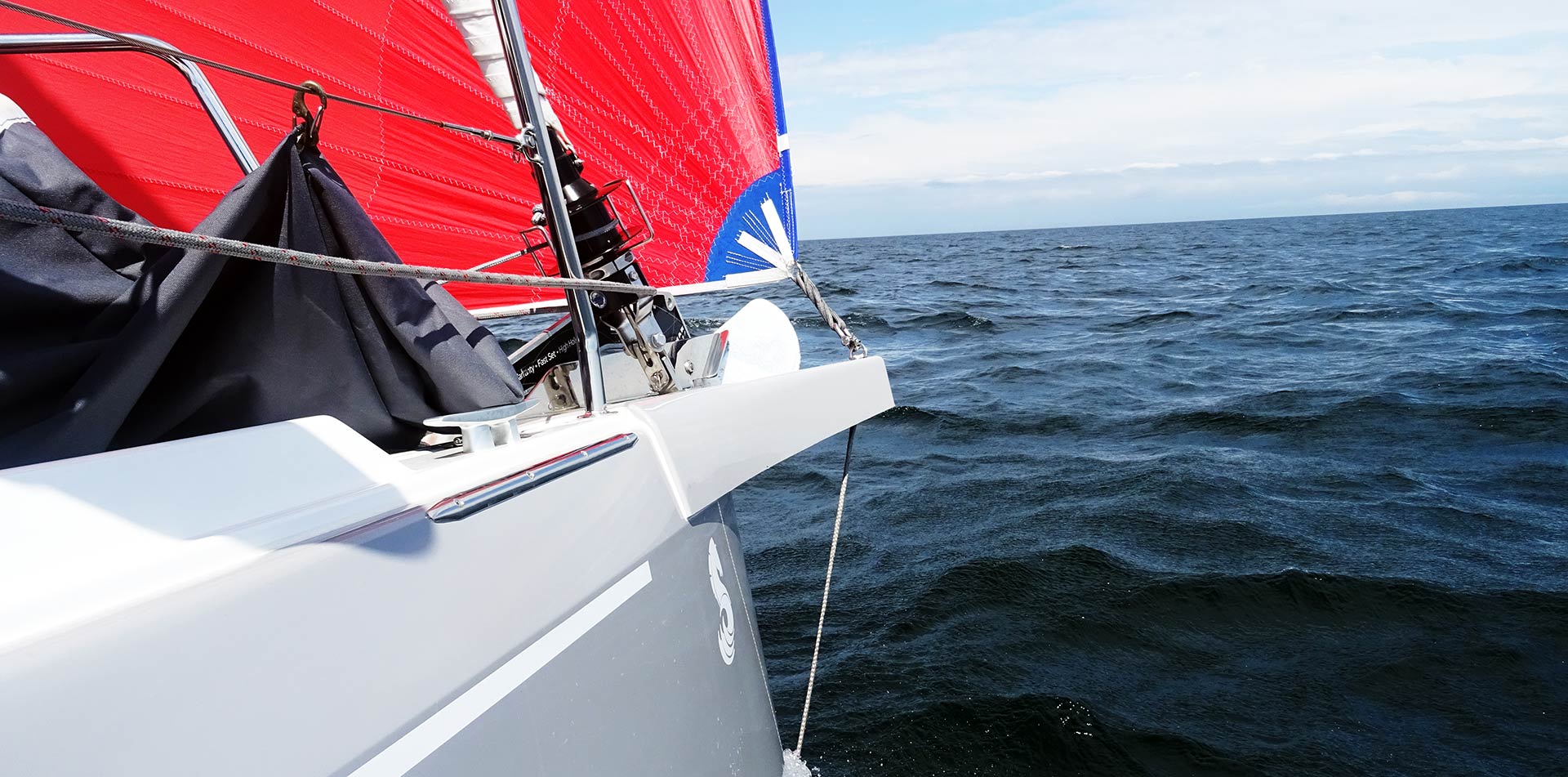
Hoisting the Gennaker was a no-brainer. We had the sheets still fitted to the reeling and the sail bag doesn´t weigh in that much. I was bending in two bowline hitches to have them connected to the sail, fitted the halyard and pulled it. The sail went up and out of the bag with no problem or entaglement and shortly after the shining big red sail was up. Tightening the windward sheet and the boat sprung to life – it was a bliss to have the engine switched off for sure!
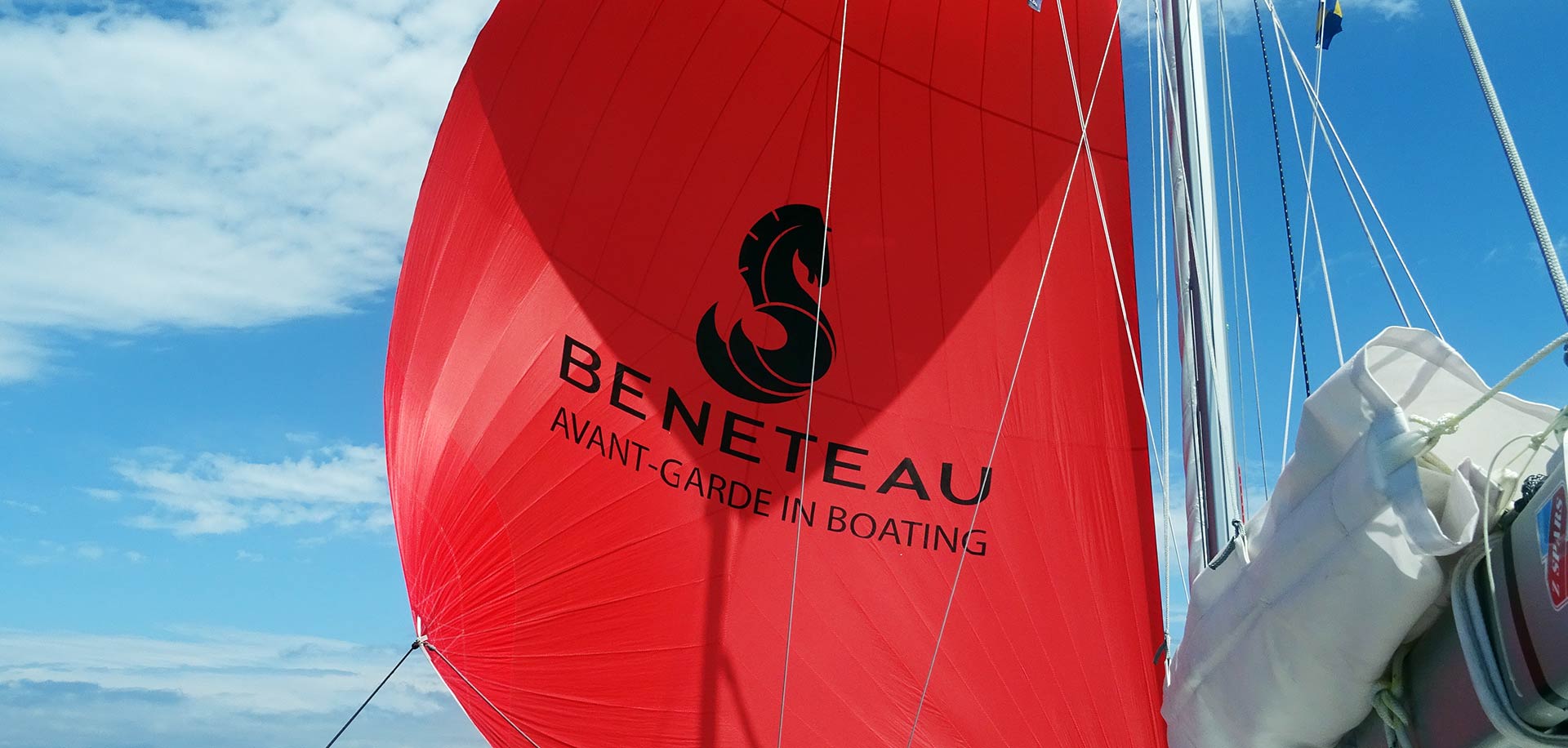
Oh, it was perfect sailing! I noted to the log: “Sailing orgasm!” with three exclamation marks and it really was. The sun was out and because the boat was on a running course there wasn´t any wind at all so that the sun could warm my body and dry my soaken wet clothing. The boat was behaving beautifully: With always more than 6.5 knots our URSUS sometimes reached 7.3 knots SOG and made me happy. I could have the sheet put on the leeward Genoa winch and no trimming was needed whatsoever.
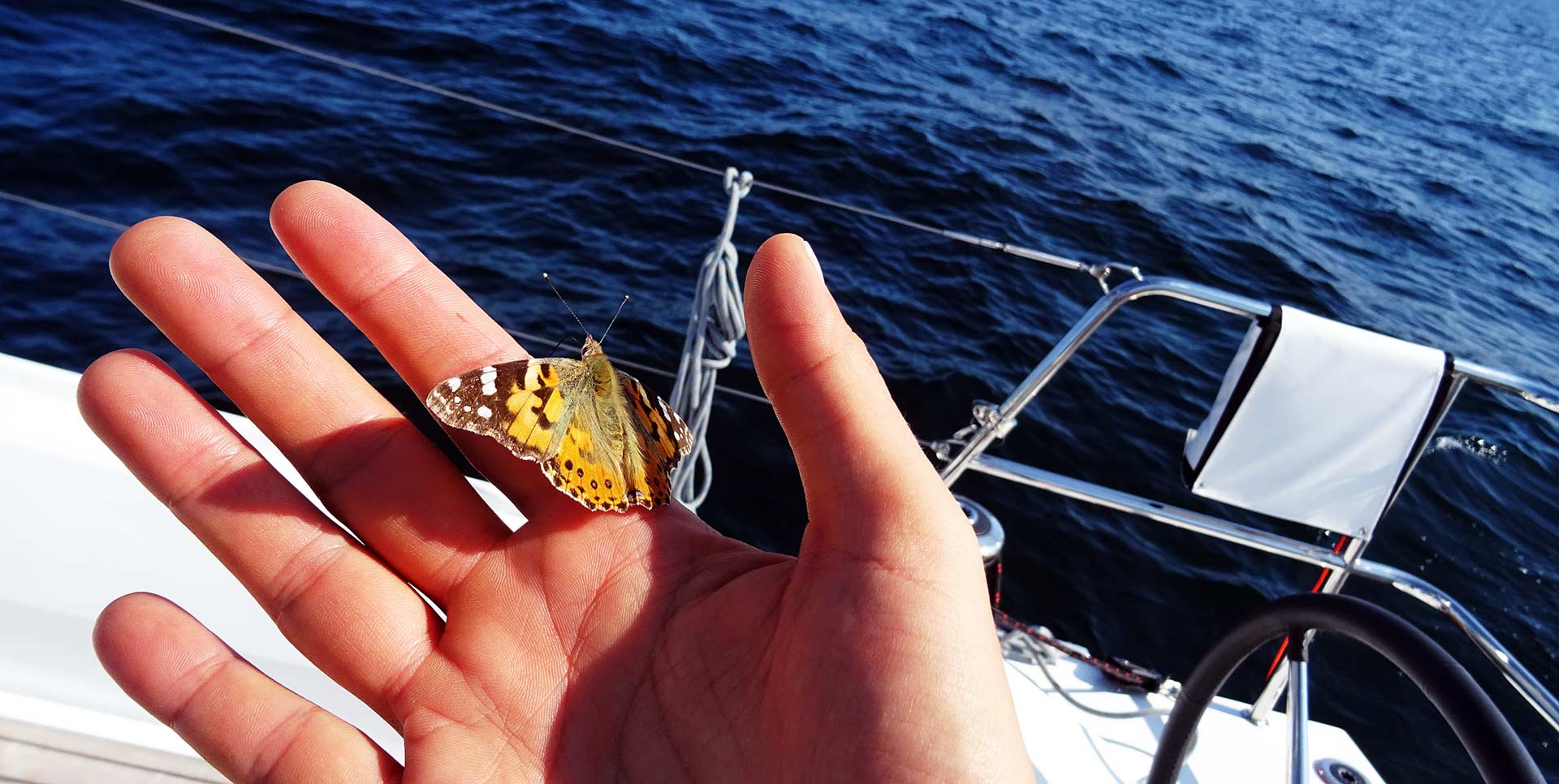
A butterfly came to take a look at the boat. The poor creature must have been blown away by the thunderstorm, I assumed, because it landed quickly and rested. I think I saw it breathing heavily although it hasn´t got real lungs. The butterfly was so exhausted, it even crawled to my hand where I held it for over 10 minutes, looking at the big body, the fluffy furl and the funny antennae. After having it sitting on the Teak I went down to cut some apple for it, I found that it had left. All the best, little butterfly!
Entering the Swedish Archipelago
I was happy. Martin got up and applauded the Gennaker, just to have his cockpit cushion arranged and sleep for another hour or so. When he woke up again, we talked about Karlskrona. I said: “This is Sweden´s most important naval port. It always has been and still is. And – it´s the sight of a Cold War story. “Whiskey on the Rocks”, when a Russian Whiskey-class submarine ran aground just off Karlskrona.” Martin May was member of the cast in “Das Boot” submarine movie and so naturally interested in everything that can dive of course.
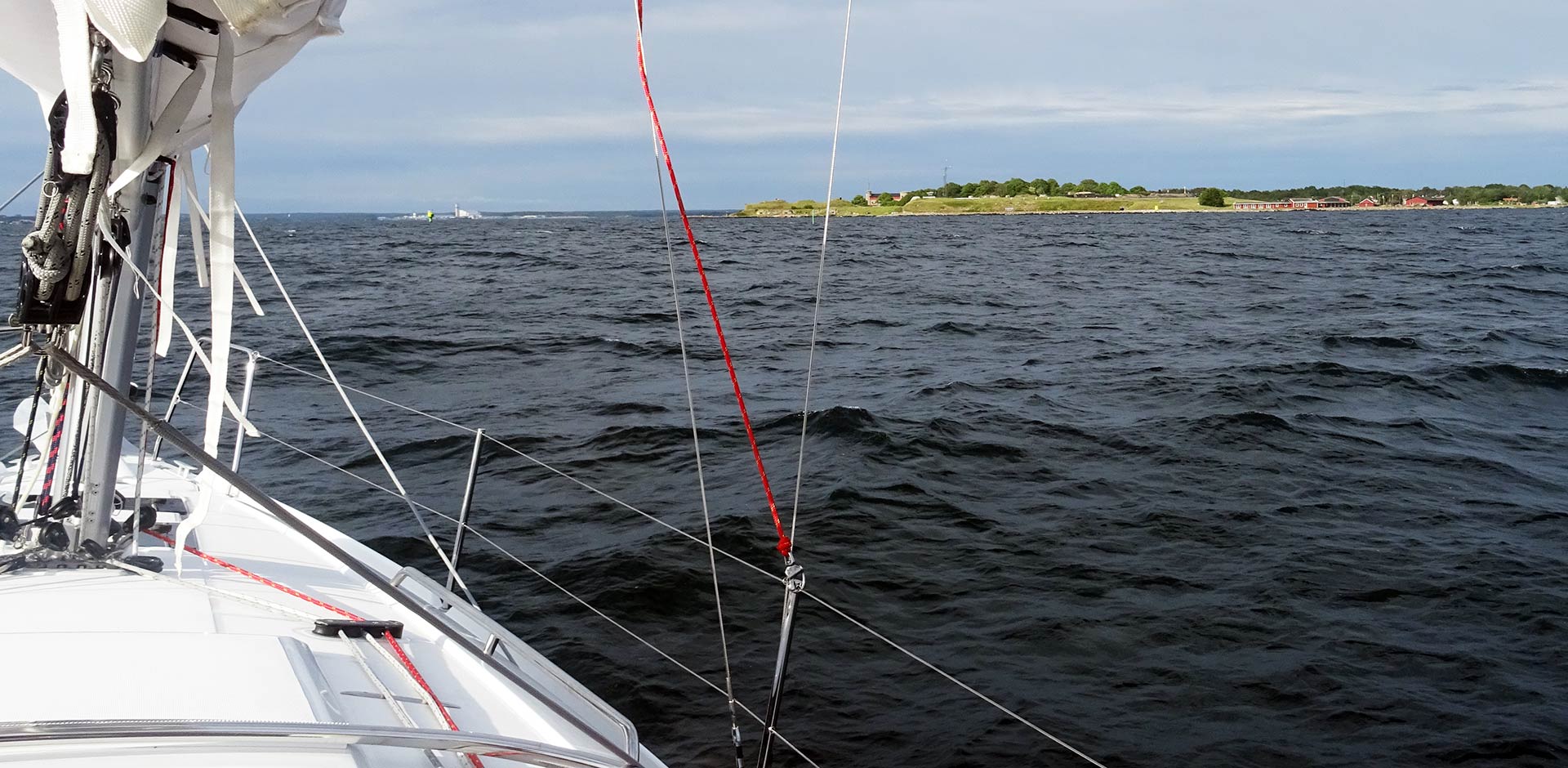
12 happy miles later I took down the Gennaker as we approached the small islands of Blekinge. I had been researching sailing in the archipelago a lot and I knew that proper navigation was the key to going about here safely. I was constantly checking my binoculars and watched the small islands, islets and stones come nearer and nearer. Then we took down the sails as the wind was easing evermore and shifting to a dead-astern which was ansailable with our Gennaker. I felt a lot safer to have the engine running again as thus I didn´t had to check for the wind but could otherwise concentrate on navigating my first encounter with the Swedish archipelago.
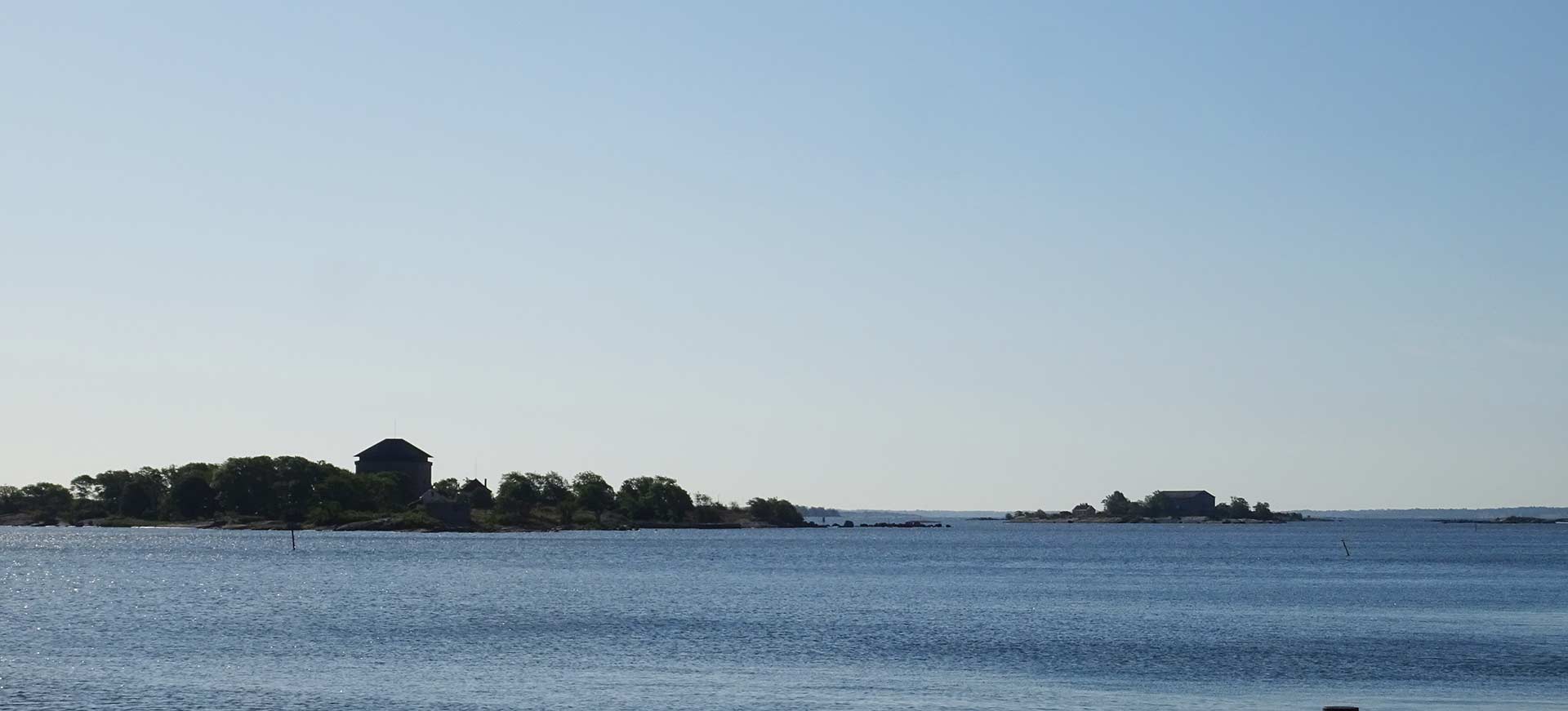
We passed Kungsholm fortress which was to our starboard side. The thick castle was once bristling with cannons of the Royal Coastal Artillery and still today serves as the right hand side of Karlkrona´s submarine defense line. It was still 4 miles to go and I was fascinated by the sudden change of nature: There were countless small islands, some barely visible as they didn´t reach out of the water for centimetres, others being steep bald rocks and bigger ones with trees and moss. I couldn´t really believe that Russian submarines – any submarine – could really try to act as intruder here. The “Whiskey on the Rocks”-incident showed how hazardous and narrow these waters were. I kept our boat strictly following the fairways which had buoys.
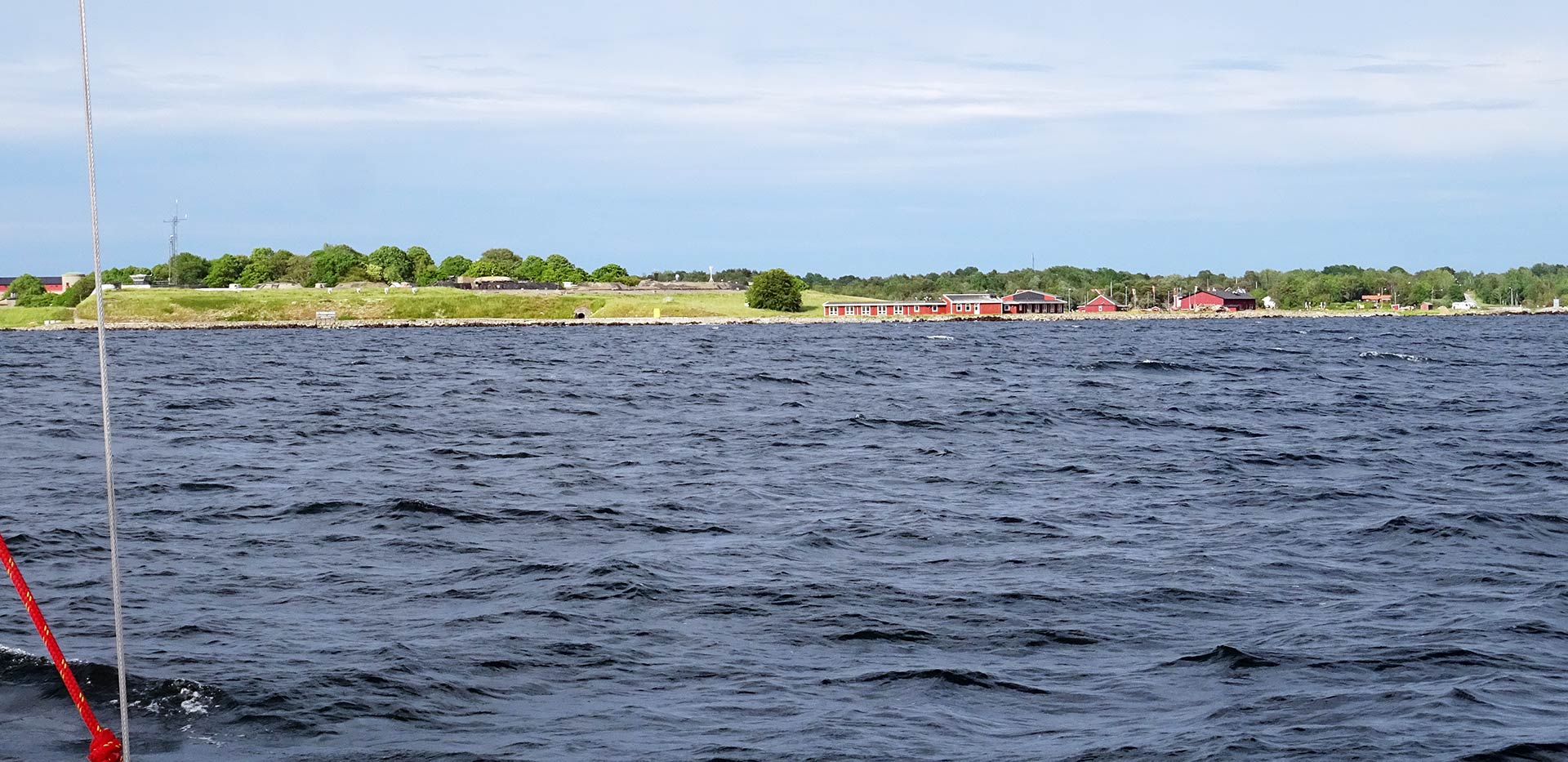
When we rounded Karlskrona we were passing by the Royal Swedish Naval Base and I could get a glimpse onto the Stealth-Frigate “Visby” which was moored here (but I refrained from taking pictures) and Martin was particularly happy in noticing that a Swedish submarine was docking here too. In order to reach the Karlskrona yachting harbour – the Stadtsmarina – you have to round the town. I was hoping that this rounding would bring us to leeward side of the current wind which had again increased to 15 to 18 knots, but it wasn´t that way. It was still blowing very hard when I landed the boat.
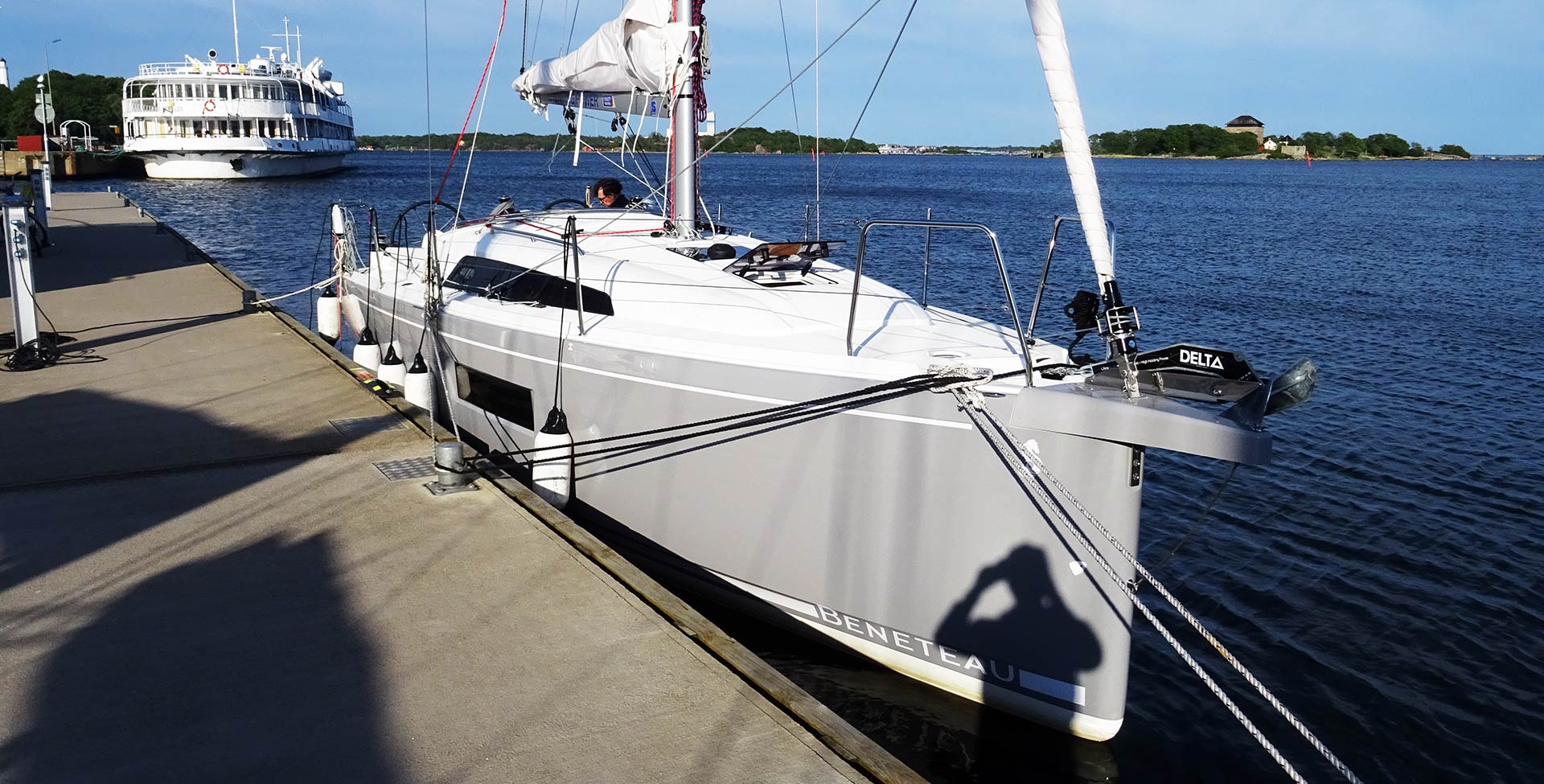
Getting up that early today now paid off: With the sun two days before Midsommar still up and shining we felt like afternoon. In fact it was 6 p.m. when we opened the traditional landing beer but this time we celebrated in style. No hurry, no hustle and most of all: Tomorrow wouldn´t be a forced waking up in the morning. I noted to the log: “Sleep granted as long as we want – tomorrow is a day off!”
First day off: Layday in Karlskrona
After paying the harbour fee – just the second time of the whole trip – we went to the showers and had it running literally forever. We went into the bathing rooms as sailors and we came out as nice smelling brand new men. I was happy. Controlling the mooring lines (the wind was still blowing hard) we went to bed and I didn´t get up as early as 8 a.m. the next day which for me is like “sleeping long”. Martin didn´t show up until it was 10 a.m. and I was perfectly fine with it. So, what to do in Karlskrona?
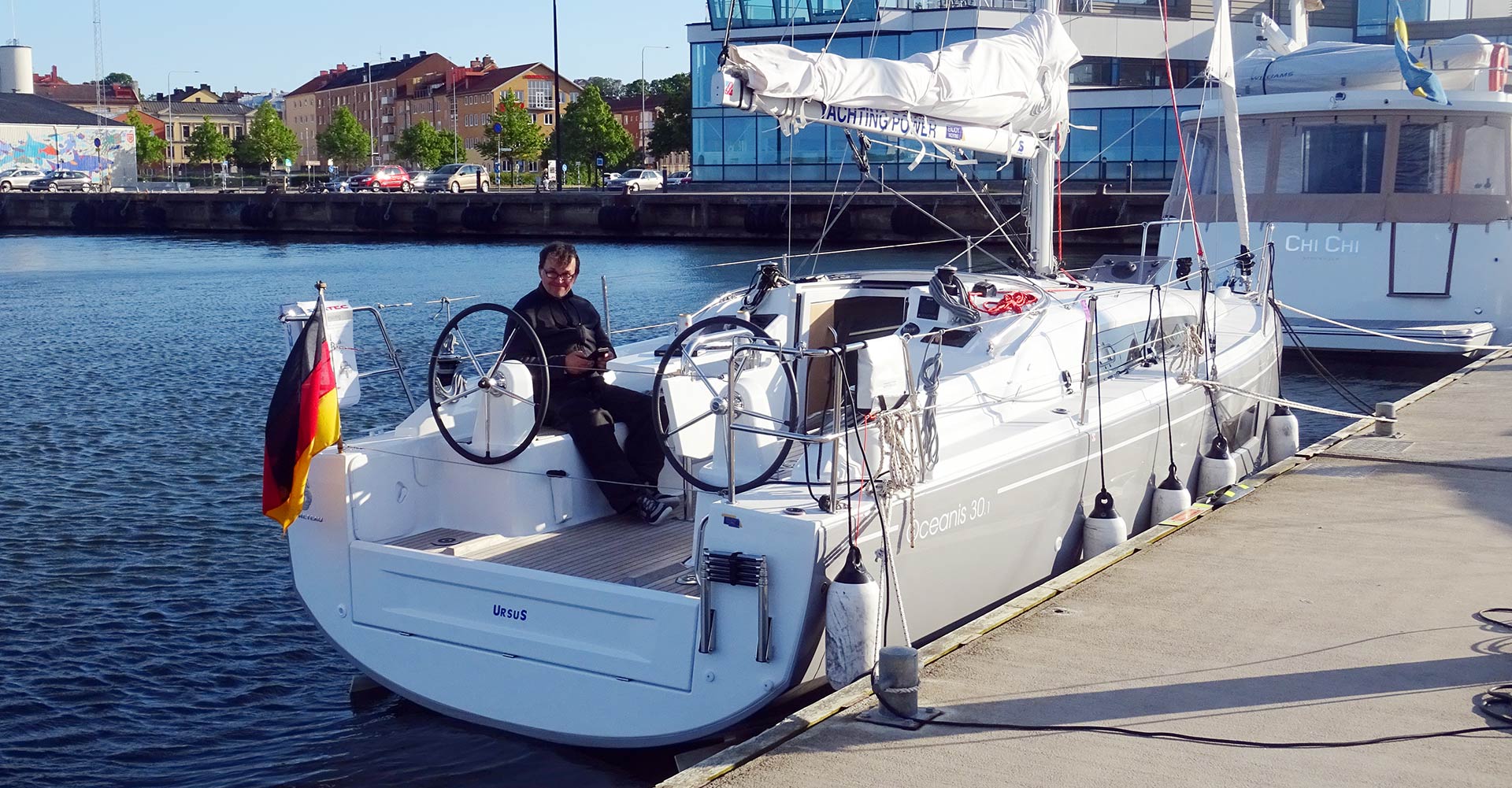
After a fine breakfast with hot coffee, toast (untoasted) with jam and some fresh fruits we packed out rucksacks and began to discover the town. Not a 15 minute walk away from our mooring site we entered the Naval Museum (free entry!) and were astonished to see Sweden´s first ever submarine and one modern sub on display. We also learned a lot about naval history of Sweden and the grat Baltic wars and could enter a rocket frigate and a torpedo boat on display. Most of all I enjoyed strolling around on the NAJADEN which was a 3-masted sailing ship that regularly logged staggering 18 knots! Wow.
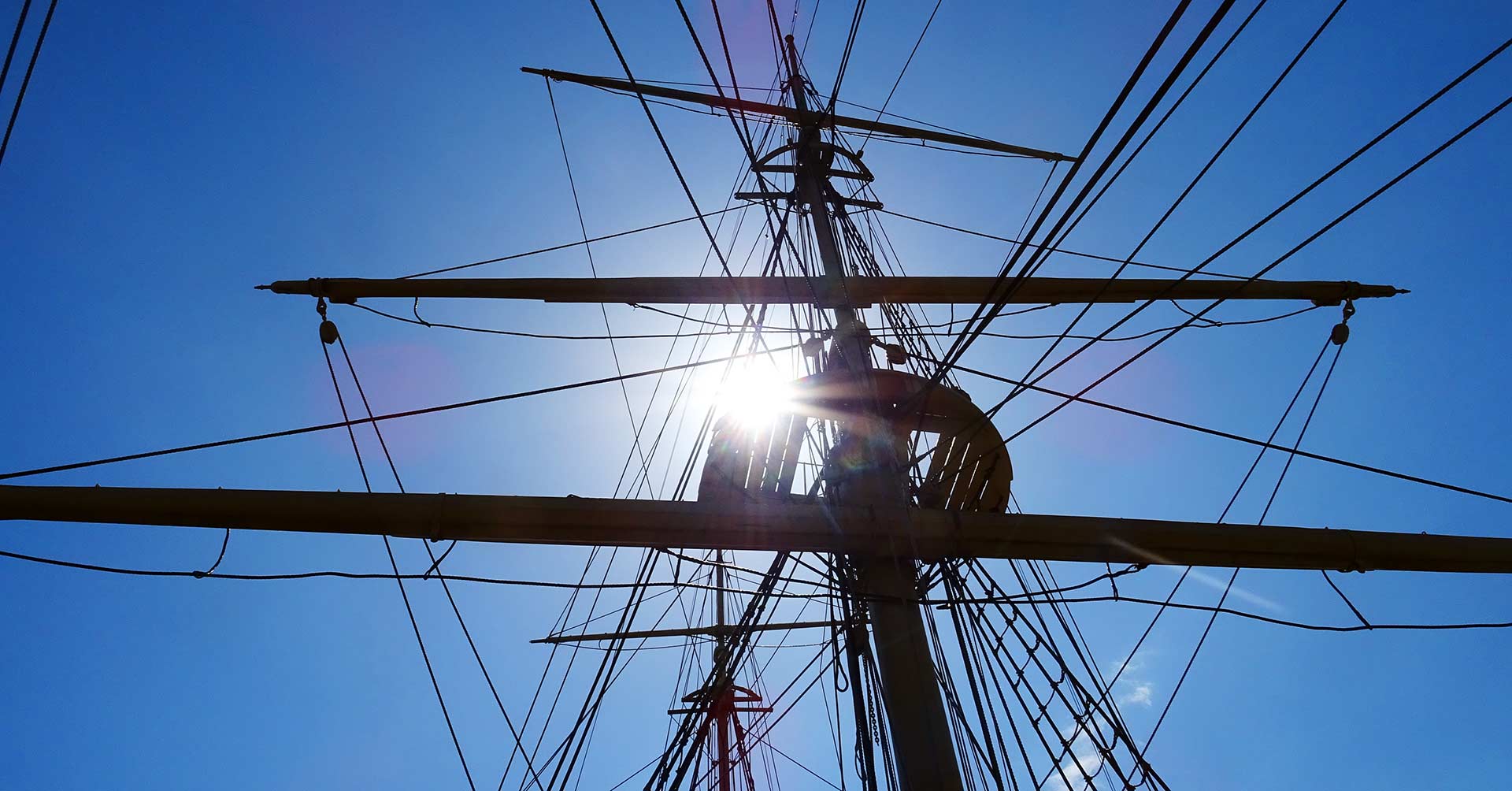
We also went on to see the town which is small and handy so you can visit every site by just walking there. To be honest, Karlskrona is a very, very small town so we finished our sightseeing well before lunch. Sitting in the sun, enjoying a really good Latte Macchiato and a big piece of chocolate fudge cake we discussed the next sailing legs: We still had more than one week to go and so I suggested not to hurry. Martin of course was perfectly fine with it.
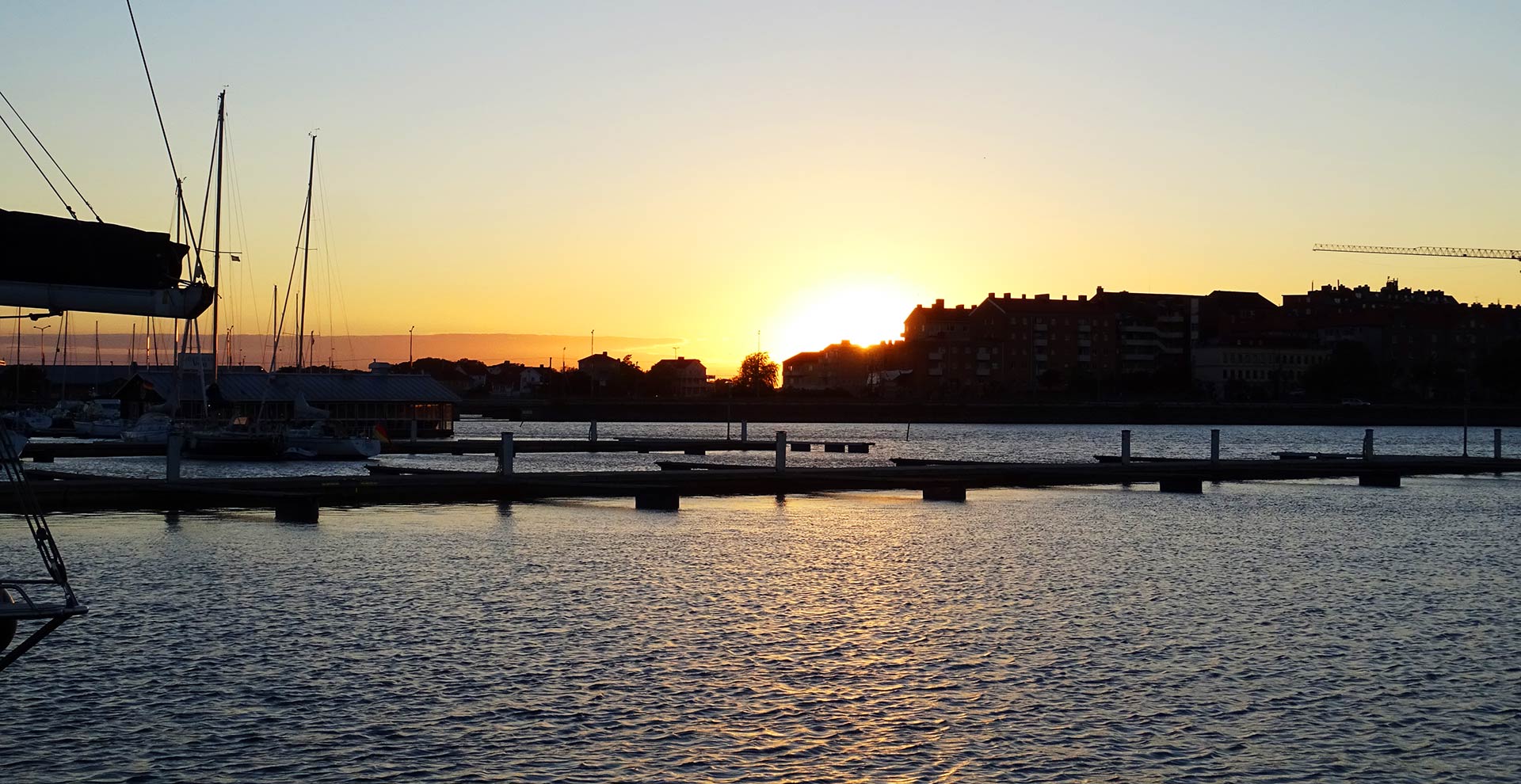
After returning to the boat and taking a big dumb (first time on real ceramics since days) we again headed off for the best steak house in town. In the meantime I had studied the charts and searched the internet. Where and how to go next? In order to reach the island of Gotland we would have to sail well North passing the some 80 miles long island of Öland. Here we would have two choices: Sailing the Kalmar sound between continental Sweden and Öland or sailing in open waters and having Öland on our port side. This was a deciding detail and I was struggling to find an answer to that question. “Never mind”, said Martin and raised his glass: “We will find a way. But for now: Let´s drink!” And right so, cheers!
You may browse all Sweden-Sailing articles by clicking on this hashtag #swedensailing
Also interesting to read:
Gennaker Sailing a Pogo 40
Harbour hustle: Navigating by night
Foul weather sailing a Beneteau First 30 R
